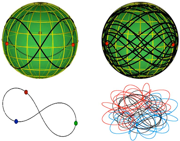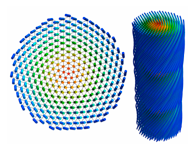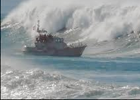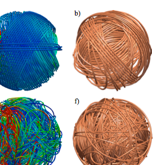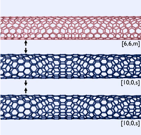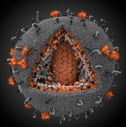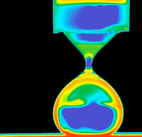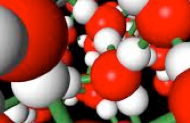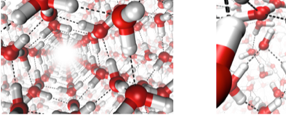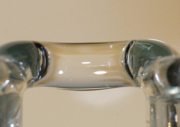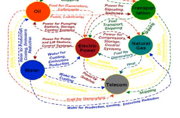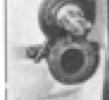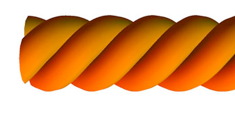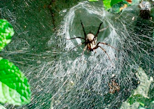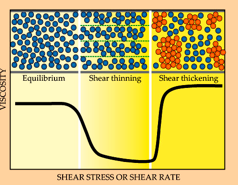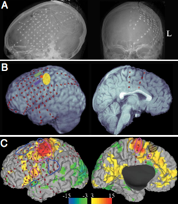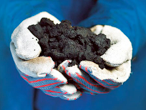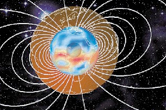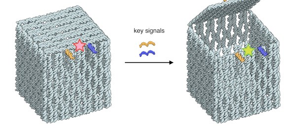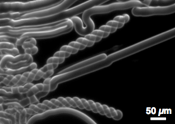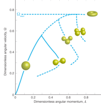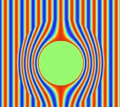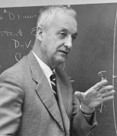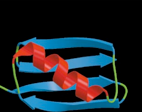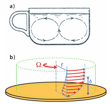Bubbles: Homo bulla. Vanitas vanitatum et omnia vanitas: bubbles are emptiness, non-liquid, a tiny cloud shielding a mathematical singularity. Born from chance, a violent and brief life ending in the union with the nearly infinite. But a wealth of phenomena spring forth from this nothingness: underwater noise, sonoluminescence, boiling, and many others. Some recent results on a ‘‘blinking bubble’’ micropump and vapor bubbles in sound fields are outlined. The last section describes Leonardo da Vinci’s observation of the non-rectlinear ascent of buoyant bubbles and justifies the name Leonardo’s paradox recently attributed to this phenomeno. Clanek.
The conductivity of strong electrolytes from stochastic density functional theory. Stochastic density functional theory is applied to analyze the conductivity of strong two species electrolytes at arbitrary field strengths. The corresponding stochastic equations for the density of the electrolyte species are solved by linearizing them about the mean density of ionic species, yielding an effective Gaussian theory. The non-equilibrium density-density correlation functions are computed and the conductivity of the electrolyte is deduced. In the bulk, our results give a simple derivation of the results of Onsager and coworkers who used very different methods. The method developed here can also be used to study electrolytes confined in one and two dimensions and interacting via either the three dimensional Coulomb interaction or the Coulomb interaction corresponding to that dimension of space. Clanek.
Hoberman sphere and the mechanical behavior of virus shells. A Hoberman sphere is an isokinetic structure patented by Chuck Hoberman that resembles a geodesic dome, but is capable of folding down to a fraction of its normal size by the scissor-like action of its joints. Colorful plastic versions have become popular as children's toys. A Hoberman sphere typically consists of six great circles corresponding to the edges of an icosidodecahedron. The Hoberman sphere can be unfolded by allowing certain members to spread apart. This can be accomplished by feeding out a string or cable in the larger models. The operation of each joint is linked to all the others in a manner conceptually similar to the extension arm on a wall-mounted shaving mirror. In the PhD thesis of Florian Kovacs the virus structures are modelled by trusses in a fashion similar to the Hoberman sphere. This could be connected with virus shell maturation and mechanical defomration. Literatura. Image shows the big Hoberman sphere in teh science museum of Tartu, Estonia, that can expand to 5.9 metres (19 ft) in diameter. The motorized sphere weighs 340 kilograms (750 lb), is constructed of aircraft-grade aluminum, and continually oscillates between its compact and expanded states.
Antipolar and Anticlinic Mesophase Order in Chromatin Induced by Nucleosome Polarity and Chirality Correlations. Contrary to the usual “rigid supermolecular assembly” paradigm of chromatin structure, we propose to analyze its eventual ordered state in terms of symmetry properties of individual nucleosomes that give rise to mesophase order parameters, like in many other soft-matter systems. Basing our approach on the Landau–de Gennes phenomenology, we describe the mesoscale order in chromatin by antipolar and anticlinic correlations of chiral individual nucleosomes. This approach leads to a unifying physical picture of a whole series of soft locally ordered states with different apparent structures, including the recently observed heteromorphic chromatin, stemming from the antipolar arrangement of nucleosomes comple- mented by their chiral twisting. Properties of these states under an external force field can reconcile apparently contradictory results of single-molecule experiments. Članek.
Geometry and optimal packing of twisted columns and filaments. Constraints and consequences of close- packing geometry of filamentous or columnar materials possessing nontrivial textures, focusing, in particular, on the common motifs of twisted and toroidal structures. The mathematical framework is presented that relates spacing between linelike, filamentous elements to their backbone orientations, highlighting the explicit connection between the interfilament metric properties and the geometry of non-Euclidean surfaces. The consequences of the hidden connection between packing in twisted filament bundles and packing on positively curved surfaces, like the Thomson problem, are demonstrated for the defect-riddled ground states of physical models of twisted filament bundles. The connection between the “ideal” geometry of fibrations of curved three-dimensional space, including the Hopf fibration, and the non-Euclidean constraints of filament packing in twisted and toroidal bundles is presented, with a focus on the broader dependence of metric geometry on the simultaneous twisting and folding of multifilament bundles. Članek.
Efficient Simulation of Inextensible Cloth. Many textiles do not noticeably stretch under their own weight. Unfortunately, for better performance many cloth solvers disregard this fact. We propose a method to obtain very low strain along the warp and weft direction using Constrained Lagrangian Mechanics and a novel fast projection method. The resulting algorithm acts as a velocity filter that easily integrates into existing simulation cod.. Our eyes are very sensitive to the behavior of fabrics, to the extent that we can identify the kind of fabric simply from its shape and motion [Griffiths and Kulke 2002]. One important fact is that most fabrics do not stretch under their own weight. Unfortunately, for many popular cloth solvers, a reduction of permissible stretching is synonymous with degradation in performance: for tractable simu- lation times one may settle for an unrealistic 10% or more strain (compare 1% and 10%, Figure 1). Our work alleviates this prob- lem by introducing a numerical solver that excels at timestepping quasi-inextensible surfaces (stretching below 1%. Clanek. Video.
Drops Impacting on a Surface. The commonly accepted description of drops impacting on a surface typically ignores the essential role of the air that is trapped between the impacting drop and the surface. Here we describe a new imaging modality that is sensitive to the behavior right at the surface. We show that a very thin film of air, only a few tens of nanometers thick, remains trapped between the falling drop and the surface as the drop spreads. The thin film of air serves to lubricate the drop enabling the fluid to skate on the air film laterally outward at surprisingly high velocities, consistent with theoretical predictions. Eventually this thin film of air breaks down as the fluid wets the surface via a spinodal-like mechanism. Our results show that the dynamics of impacting drops are much more complex than previously thought, with a rich array of unexpected phenomena that require rethinking classic paradigms. Clanek. Clanek.
Can a planet have the shape of a donut? According to the laws of physics, a planet the shape of a donut, or toroid, could actually exist — but it's extremely unlikely to ever form naturally. For all practical purposes planets are liquid blobs with no surface tension: the strength of rock is nothing compared to the weight of a planet. Their surfaces will be equipotential surfaces of gravity plus centrifugal potential. If they were not, there would be some spots that could reduce their energy by flowing to a lower potential. Another obvious fact is that there exists an upper rotation rate beyond which the planet falls apart: the centrifugal force at the equator becomes larger than gravity and material starts to flow into space. The equilibrium shapes of self-gravitating rotating ellipsoidal planets have been extensively analyzed. Newton started it (leading to some early heroic expeditions to ascertain the true shape of Earth), and Maclaurin refined it. Then Jacobi discovered that high rotation rates ellipsoids with unequal axes were more stable than the oblate ellipsoids of Maclaurin. Chandrasekar has a nice history of the field. Since then computers have become available, and analytical and numerical calculations of more complex or the relativistic case have been performed.. Literatura.
A solution to the Kelvin wake angle controversy. Gravity waves generated by an object moving at constant speed at the water surface form a specific pattern commonly known as the Kelvin wake. It was proved by Lord Kelvin that such a wake is delimited by a constant angle = 19.47{\deg}. However a recent study by Rabaud and Moisy based on the observation of airborne images showed that the wake angle seems to decrease as the Froude number Fr increases, scaling as 1/Fr for large Froude numbers. To explain such observations the authors make the strong hypothesis that an object of size b cannot generate wavelengths larger than b thus leading to unrealistic pressure fields to model the object. With no need of such an assumption, we here analytically show that the angle corresponding to the maximum amplitude of the waves scales as 1/Fr for large Froude numbers whereas the Kelvin angle remains constant for all Fr. arXiv:1309.6751v1 [physics.flu-dyn]
Elastic Platonic Shells. On microscopic scales, the crystallinity of flexible tethered or cross linked membranes determines their mechanical response. We show that by controlling the type, number and distribution of defects on a spherical elastic shell, it is possible to direct the morphology of these structures. Our numerical simulations show that by deflating a crystalline shell with defects, we can create elastic shell analogs of the classical Platonic solids. These morphologies arise via a sharp buckling transition from the sphere which is strongly hysteretic in loading-unloading. We construct a minimal Landau theory for the transition using quadratic and cubic invariants of the spherical harmonic modes. Our approach suggests methods to engineer shape into soft spherical shells using a frozen defect topology. http://arxiv.org/abs/1305.6618
The tree-body problem dates back to the 1680s. Isaac Newton had already shown that his new law of gravity could always predict the orbit of two bodies held together by gravity—such as a star and a planet—with complete accuracy. The orbit is basically always an ellipse. However, Newton couldn't come up with a similar solution for the case of three bodies orbiting one another. For 2 centuries, scientists tried different tacks until the German mathematician Heinrich Bruns pointed out that the search for a general solution for the three-body problem was futile, and that only specific solutions—one-offs that work under particular conditions—were possible. Generally, the motion of three bodies is now known to be nonrepeating. It's the sort of abstract puzzle that keeps a scientist awake at night: Can you predict how three objects will orbit each other in a repeating pattern? In the 300 years since this "three-body problem" was first recognized, just three families of solutions have been found. Now, two physicists have discovered 13 new families. It's quite a feat in mathematical physics, and it could help astrophysicists understand new planetary systems. Clanek.
Turning Pull Into Push? It's textbook physics: An electric charge near the surface of a material gets pulled toward the surface. However, if the charge is spread out into the right shape and moves fast enough, that attraction becomes a repulsion, one physicist calculates. The odd finding could help physicists avoid unexpected effects when guiding beams of particles such as electrons. "At first I thought this was completely wrong, but when you think about the situation, it's not," says Primož Rebernik Ribič, a physicist at the Swiss Federal Institute of Technology in Lausanne, who presents his calculation online today in Physical Review Letters. However, not everybody agrees that his analysis is correct. Clanek.
Why is surface tension a force parallel to the interface? A paperclip can float on water. Drops of mercury refuse to spread on a surface. These capillary phenomena are macroscopic manifestations of molecular interactions, and can be explained in terms of surface tension. For students, the concept of surface tension is quite challenging since the mi- croscopic intuition is often in conflict with the common macroscopic interpretations. In this paper we address a number of conceptual questions that are often encountered when teaching capillarity. By answering these questions we provide a perspective that reconciles the macroscopic viewpoints, from thermodynamics or fluid mechanics, and the microscopic perspective from statistical physics. Clanek.
Time crystals. Spontaneous symmetry breaking is ubiquitous in nature. It occurs when the ground state (classically, the lowest energy state) of a system is less symmetrical than the equations governing the system. Examples in which the symmetry is broken in excited states are common—one just needs to think of Kepler’s elliptical orbits, which break the spherical symmetry of the gravitational force. But spontaneous symmetry breaking refers instead to a symmetry broken by the lowest energy state of a system. Well-known examples are the Higgs boson (due to the breaking of gauge symmetries), ferromagnets and antiferromagnets, liquid crystals, and superconductors. While most examples come from the quantum world, spontaneous symmetry breaking can also occur in classical systems. Clanek.
Brownian motion at short time scales. Brownian motion has played important roles in many different fields of science since its origin was first explained by Albert Einstein in 1905. Einstein’s theory of Brownian motion, however, is only applicable at long time scales. At short time scales, Brownian motion of a suspended particle is not completely random, due to the inertia of the particle and the surrounding fluid. Moreover, the thermal force exerted on a particle suspended in a liquid is not a white noise, but is colored. Recent experimental developments in optical trapping and detection have made this new regime of Brownian motion accessible. This review summarizes related theories and recent experiments on Brownian motion at short time scales, with a focus on the measurement of the instantaneous velocity of a Brownian particle in a gas and the observation of the transition from ballistic to diffusive Brownian motion in a liquid. Clanek.
How do mosquito eggs self-assemble on the water surface? This work reports a detailed numerical study of the behavior of ellipsoid-shaped particles ad- sorbed at fluid interfaces. Former experiments have shown that micrometer-sized prolate ellipsoids aggregate under the action of strong and long-ranged capillary interactions. The latter are due to nonplanar contact lines and to the resulting deformations of the interface in the vicinity of the trapped objects. We first consider the case of a single ellipsoid and examine in detail the influence of contact angle and ellipsoid aspect ratio on interfacial distortions. We then focus on two contacting ellipsoids and study the optimum packing configuration depending on their size and/or aspect ratio mismatch. We thoroughly explore the variety of contact configurations between both ellipsoids and provide corresponding energy maps. Whereas the side-by-side configuration is the most stable state for identical ellipsoids, we find that the mismatched pair adopts an “arrow” configuration in which a finite angle exists between the particles long axes. Such arrows are actually seen in experiments with micron-sized ellipsoids and similarly with millimeter-sized mosquito eggs. Clanek.
Physicists solve Casimir conundrum. Physicists in the US may have ended a decade-old debate about how the Casimir force – which affects objects separated by tiny distances – should be calculated for two metal objects. They say that the so-called Drude model, which treats metal as a collection of billiard-ball-like positive ions and electrons, wins out over the "plasma model", which assumes the electrons move in a fixed lattice of positive ions. Understanding how to determine the force could play an important role in the design of micrometre- and nanometre-sized machines. The Casimir force was first predicted in 1948 by Dutch physicist Hendrik Casimir, who considered what happens when two uncharged, perfectly conducting metal plates are placed opposite one another in a vacuum. According to quantum mechanics, the energy of an electromagnetic field in a vacuum is not zero but continuously fluctuates around a certain mean value. However, resonance means that only certain wavelengths will exist between two plates separated by a particular distance. Clanek.
How to construct the perfect sandcaste.Just a bit of water enables one to turn a pile of dry sand into a spectacular sandcastle. Too much water however will destabilize the material, as is seen in landslides. Here we investigated the stability of wet sand columns to account for the maximum height of sandcastles. We find that the columns become unstable to elastic buckling under their own weight. This allows to account for the maximum height of the sand column; it is found to increase as the 2/3 power of the base radius of the column. Measuring the elastic modulus of the wet sand, we find that the optimum strength is achieved at a very low liquid volume fraction of about 1%. Knowing the modulus we can quantitatively account for the measured sandcastle heights. Članek.
Textbook Electrodynamics May Contradict Relativity. A basic equation of electricity and mag- netism is wrong, one scientist claims. The classic formula for the force exerted by electric and magnetic fields—the so-called Lorentz force—clashes with Einstein’s special theory of relativity, says Masud Mansuripur, an electrical engineer at the University of Arizona in Tucson. Others doubt the claim but have not found a flaw in the simple argument that challenges century-old textbook physics. Clanek.
Electric charge disorder: A key to biological order? Theoretical physicist Ali Naji from the IPM in Tehran and the University of Cambridge, UK, and his colleagues have shown how small random patches of disordered, frozen electric charges can make a difference when they are scattered on surfaces that are overall neutral. These charges induce a twisting force that is strong enough to be felt as far as nanometers or even micrometers away. These results, published in EPJ E, could help to understand phenomena that occur on surfaces such as those of large biological molecules. To measure the strength of the twist that acts on a randomly charged surface, the authors used a sphere which was mounted like a spinning top next to a randomly charged flat substrate. Because small amounts of positive and negative charges were spread in a disordered mosaic throughout both surfaces, they induced transient attractive or repulsive twisting forces. This was regardless of the surfaces' overall electrical neutrality, thus making the sphere spin. Using statistical averaging methods, the authors studied the fluctuations of these forces. Physics News. Science daily. Nano werk. Springer news.
Structure and stability of charged clusters. When a cluster or nanodroplet bears charge, its structure and thermodynamics are altered and, if the charge exceeds a certain limit, the system becomes unstable with respect to fragmentation. Some of the key results in this area were derived by Rayleigh in the nineteenth century using a continuum model of liquid droplets. Here we revisit the topic using a simple particle-based description, presenting a systematic case study of how charge affects the physical properties of a Lennard-Jones cluster composed of 309 particles. We find that the ability of the cluster to sustain charge depends on the number of particles over which the charge is distributed—a parameter not included in Rayleigh’s analysis. Furthermore, the cluster may fragment before the charge is strong enough to drive all charged particles to the surface. The charged particles in stable clusters are therefore likely to reside in the cluster’s interior even without considering solvation effects. Clanek.
Electrostatics of two charged conducting spheres. John Lekner proves that two charged conducting spheres will almost always attract each other at close approach, even when they have like charges. The one exception is when the two spheres have the same charge ratio that they would obtain by being brought into contact. In this case, they repel, and we derive an analytical expression for the force at contact, for any size ratio, generalizing a force formula for equal spheres obtained by Kelvin in 1853. We also give the electrostatic energy of two arbitrarily charged spheres, and its analytical forms at large and small separations. Expressions are derived for the surface charge densities of the two spheres. Attraction occurs between two positively charged spheres because of mutual polarization: one of the spheres obtains a negatively charged region (neighbouring the other sphere). Clanek.
The secret molecular life of soap bubbles. Nature can be extremely devious in the way it hides its secrets. Sometimes the most remarkable and profound insights are staring us right in the face every day in the most mundane phenomena. For instance, we have all seen the spectacular colors that can appear in soap bubbles. Borrowing his lovely images until I can produce my own! These colors are produced by optical interference, as we will discuss below; the “thin film optics” that creates bright colors in soap films also results in the bright colors of oil slicks. Most of us would look at a soap film image and marvel at the beautiful rainbow colors; others would investigate the optics underlying them. But it took an exceptional physicist, Jean Baptiste Perrin (1870-1942), to realize that these colors concealed something more: direct evidence that matter consists of discrete atoms and molecules! Clanek.
The Shape of a Ponytail and the Statistical Physics of Hair Fiber Bundles. A general continuum theory for the distribution of hairs in a bundle is developed, treating indi- vidual fibers as elastic filaments with random intrinsic curvatures. Applying this formalism to the iconic problem of the ponytail, the combined effects of bending elasticity, gravity, and orientational disorder are recast as a differential equation for the envelope of the bundle, in which the compress- ibility enters through an ‘equation of state’. From this, we identify the balance of forces in various regions of the ponytail, extract a remarkably simple equation of state from laboratory measurements of human ponytails, and relate the pressure to the measured random curvatures of individual hairs. http://arxiv.org/pdf/1204.0371v1.pdf
Electromagnetic force density in dissipative isotropic media. An expression for the macroscopic force density that a narrow-band electromagnetic field imposes on a dissipative isotropic medium. The result is obtained by averaging the microscopic form for Lorentz force density. The derived expression allows us to calculate realistic electromagnetic forces in a wide range of materials that are described by complex-valued electric permittivity and magnetic permeability. The three-dimensional energy–momentum tensor in our expression reduces for lossless media to the so-called Helmholtz tensor that has not been contradicted in any experiment so far. The momentum density of the field does not coincide with any well-known expression, but for non-magnetic materials it matches the Abraham expression. Clanek.
Defects in Crystalline Packings of Twisted Filament Bundles. We develop the theory of the coupling between in-plane order and out-of-plane geometry in twisted, two-dimensionally ordered filament bundles based on the non-linear continuum elasticity theory of columnar materials. We show that twisted textures of filament backbones necessarily introduce stresses into the cross-sectional packing of bundles and that these stresses are formally equivalent to the geometrically-induced stresses generated in thin elastic sheets that are forced to adopt spherical curvature. As in the case of crystalline order on curved membranes, geometrically-induced stresses couple elastically to the presence of topological defects in the in-plane order. We derive the effective theory of multiple disclination defects in the cross section of bundle with a fixed twist and show that above a critical degree of twist, one or more 5-fold disclinations is favored in the elastic energy ground state. We study the structure and energetics of multi-disclination packings based on models of equilibrium and non-equilibrium cross-sectional order. Clanek in clanek.
The physics of wind-blown sand and dust. The transport of dust and sand by wind is a potent erosional force, creates sand dunes and ripples, and loads the atmosphere with suspended dust aerosols. This article presents an extensive review of the physics of wind-blown sand and dust on Earth and Mars. Specifically, we review the physics of aeolian saltation, the formation and development of sand dunes and ripples, the physics of dust aerosol emission, the weather phenomena that trigger dust storms, and the lifting of dust by dust devils and other small-scale vortices. We also discuss the physics of wind- blown sand and dune formation on Venus and Titan.Clanek.
Analogy: between cassical Hamiltonian mechanics and Maxwell relations in thermodynamics. It came as a bit of a shock last week when I realized that some of the equations I’d learned in thermodynamics were just the same as equations I’d learned in classical mechanics—with only the names of the variables changed, to protect the innocent. Why didn’t anyone tell me? For example: everybody loves Hamilton’s equations: there are just two, and they summarize the entire essence of classical mechanics. Most people hate the Maxwell relations in thermodynamics: there are lots, and they’re hard to remember. Stran.
Periodic Table of Virus Capsids: Implications for Natural Selection and Design. The Background: For survival, most natural viruses depend upon the existence of spherical capsids: protective shells of various sizes composed of protein subunits. So far, general evolutionary pressures shaping capsid design have remained elusive, even though an understanding of such properties may help in rationally impeding the virus life cycle and designing efficient nano-assemblies. Principal Findings: This report uncovers an unprecedented and species-independent evolutionary pressure on virus capsids, based on the the notion that the simplest capsid designs (or those capsids with the lowest ‘‘hexamer complexity’’, Ch) are the fittest, which was shown to be true for all available virus capsids. The theories result in a physically meaningful periodic table of virus capsids that uncovers strong and overarching evolutionary pressures, while also offering geometric explanations to other capsid properties (rigidity, pleomorphy, auxiliary requirements, etc.) that were previously considered to be unrelatable properties of the individual virus. Significance: Apart from describing a universal rule for virus capsid evolution, our work (especially the periodic table) provides a language with which highly diverse virus capsids, unified only by geometry, may be described and related to each other. Finally, the available virus structure databases and other published data reiterate the predicted geometry- derived rules, reinforcing the role of geometry in the natural selection and design of virus capsids. Clanek.
Counting wrinkles reveals pressure. Poking a living cell and counting the number of wrinkles that form could provide scientists with a new way of measuring its internal pressure. That is the claim of physicists in the UK, the US and France, who have shown that the number of wrinkles that appear on a pressurized shell is determined by its internal pressure. The technique could be used to study how cells react to changes in their environment and improve tiny capsules used by the pharmaceutical industry. If you push your finger into a beach ball, the indentation that you create will include a number of wrinkles that radiate outwards from your finger. However, if you do the same thing with a table-tennis ball, the result will be a much simpler three-lobed geometric pattern (see figure). An important difference between these examples is that the beach ball is pressurized and the table-tennis ball is not. Dominic Vella of the University of Oxford and colleagues at Northeastern University in the US and the University of Lyon in France thought that this effect could be used to create a new technique for measuring the pressure inside such a shell – without the need to make a hole in it. Now, by using theory, computer simulations and experiments carried out on an exercise ball, they have worked out the relationship between the internal pressure of a shell, its elastic properties and the number of wrinkles that appear when it is prodded. (The research is described in http://physicsworld.com/cws/article/news/47586 and in Phys. Rev. Lett. 107 174301 (2011).)
MINIMAL SURFACES BOUNDED BY ELASTIC LINE. The classical Plateau’s problem consists of finding the surface of least area that spans a given rigid boundary curve. A physical realization of the problem is obtained by dipping a stiff wire frame of some given shape in soapy water and then removing it. But what happens if a soap film spans a loop of inextensible but flexible wire? We consider this simple query that couples the Plateau’s problem to Euler’s Elastica: a special class of curves of given length that minimize their total squared curvature energy. The natural marriage of two of the oldest geometrical problems linking physics and mathematics leads to a quest for the shape of a minimal surface bounded by an elastic line: the Euler-Plateau problem. We use a combination of simple physical experiments with soap films that span soft filaments, scaling concepts, exact and asymptotic analysis combined with numerical simulations to explore some of the richness of the shapes that result. Our study also raises a number of interesting questions of intrinsic interest in geometry and its natural links to a range of disciplines including materials science, polymer physics, architecture and even art. Giomi and Mahadevan, arXiv:1108.0597v1 [math.DG] 2 Aug 2011
Pendulum, Drops and Rods: a physical analogy.Abstract. A liquid meniscus, a bending rod (also called elastica) and a simple pendulum are all des- cribed by the same non-dimensional equation. The oscillatory regime of the pendulum corresponds to buckling rods and pending drops, and the high-velocity regime corres- ponds to spherical drops, puddles and multiple rod loopings. We study this analogy in a didactical way and discuss how despite this common governing equation, the three systems are not completely equivalent. We also consider the cylindrical deformations of an inextensible, flexible membrane containing a liquid, which in some sense interpolates between the meniscus and rod conformations. Roman, Gay and Clanet.
Elastons: Unified Simulation of Elastic Rods, Shells, and Solids. Objects can not only transition between solid, shell, and rod in space, regime changes can also develop over time. In plastic and viscous deformations, for instance, material can be stretched into thin sheets or strands, whose elastic behavior can correctly be cap- tured by our approach. The topological changes induced by cutting and fracturing can also generate material with small features in all three dimensions that should be captured by the simulation system. Elastic, plastic and hydrodynamic simulations based on a unified description of materials and shapes. The results of the simulations can be grasped in this beautiful video created by Sebastian Martin, Peter Kaufmann, Mario Botsch, Eitan Grinspun and Markus Gros sof the Elaston company. The literaure is available here.
Rogue Wave Observation in a Water Wave Tank. The conventional definition of rogue waves in the ocean is that their heights, from crest to trough, are more than about twice the significant wave height, which is the average wave height of the largest one-third of nearby waves. When modeling deep water waves using the nonlinear Schrödinger equation, the most likely candidate satisfying this criterion is the so-called Peregrine solution. It is localized in both space and time, thus describing a unique wave event. Until now, experiments specifically designed for observation of breather states in the evolution of deep water waves have never been made in this double limit. In the present work, we present the first experimental results with observations of the Peregrine soliton in a water wave tank. Literatura: A. Chabchoub, N. P. Hoffmann, and N. Akhmediev, Phys. Rev. Lett. 106, 204502 (2011) in se novi clanek Phys. Rev. Lett. 107 184502.
Size distribution and structure of Barchan dune fields. Barchans are isolated mobile dunes often orga- nized in large dune fields. Dune fields seem to present a characteristic dune size and spacing, which suggests a co- operative behavior based on dune interaction. In Duran et al. (2009), we propose that the redistribution of sand by collisions between dunes is a key element for the stability and size selection of barchan dune fields. This approach was based on a mean-field model ignoring the spatial distribution of dune fields. Here, we present a simplified dune field model that includes the spatial evolution of individual dunes as well as their interaction through sand exchange and binary colli- sions. As a result, the dune field evolves towards a steady state that depends on the boundary conditions. Comparing our results with measurements of Moroccan dune fields, we find that the simulated fields have the same dune size distri- bution as in real fields but fail to reproduce their homogeneity along the wind direction. Literatura: clanek.
Evidence that cosmic rays seed clouds. By firing a particle beam into a cloud chamber, physicists in Denmark and the UK have shown how cosmic rays could stimulate the formation of water droplets in the Earth's atmosphere. The researchers say this is the best experimental evidence yet that the Sun influences the climate by altering the intensity of the cosmic-ray flux reaching the Earth's surface. The now conventional view on global warming, as stated by the Intergovernmental Panel on Climate Change, is that most of the warming recorded in the past 50 years has been caused by emissions of manmade greenhouse gases. But some scientists argue that the Sun might have a significant influence on changes to the Earth's climate, pointing out that in centuries past there has been a close correlation between global temperatures and solar activity. However, changes to the Sun's brightness are believed to have altered temperatures on Earth by no more than a few hundredths of a degree in the last 150 years. Researchers have therefore been investigating ways that the Sun could indirectly modify the Earth's climate, and one hypothesis, put forward by Henrik Svensmark of the National Space Institute in Copenhagen, posits a link between solar activity and cosmic-ray flux. Literatura: Enghoff, M. B., J. O. P. Pedersen, U. I. Uggerhøj, S. M. Paling, and H. Svensmark (2011), Aerosol nucleation induced by a high energy particle beam, Geophys. Res. Lett., 38, L09805, doi:10.1029/2011GL047036 in pa http://physicsworld.com/cws/article/news/45982.
Packing of elastic wires and polymers in spherical cavities. Paper 1: We investigate the morphologies and maximum packing density of thin wires packed into spherical cavities. Using simulations and experiments, we find that ordered as well as disordered structures emerge, depending on the amount of internal torsion. We find that the highest packing densities are achieved in low torsion packings for large systems, but in high torsion packings for small systems. An analysis of both situations is given in terms of energetics and comparison is made to analytical models of DNA packing in viral capsids. Literatura: clanek Packing of elastic wires in spherical cavities Stoop at al. PRL 2011. Paper 2: We investigate the tight packing of nematic polymers inside a confining hard sphere. We model the polymer via the continuum Frank elastic free energy augmented by a simple density dependent part as well as by taking proper care of the connectivity of the polymer chains when compared with simple nematics. The free energy ansatz is capable of describing an orientational ordering transition within the sample between an isotropic polymer solution and a polymer nematic phase. We solve the Euler-Lagrange equations numerically with the appropriate boundary conditions for the director and density field and investigate the orientation and density profile within a sphere. Two important parameters of the solution are the exact locations of the beginning and the end of the polymer chain. Pending on their spatial distribution and the actual size of the hard sphere enclosure we can get a plethora of various configurations of the chain exhibiting different defect geometry. Literatura: clanek.
Foaming in stout beers. We review the differences between bubble formation in champagne and other carbonated drinks, and stout beers which contain a mixture of dissolved nitrogen and carbon dioxide. The presence of dissolved nitrogen in stout beers gives them a number of properties of interest to connoisseurs and physicists. These remarkable properties come at a price: stout beers do not foam spontaneously and special technology, such as the widgets used in cans, is needed to promote foaming. Nevertheless the same mechanism, nucleation by gas pockets trapped in cellulose fibres, responsible for foaming in carbonated drinks is active in stout beers, but at an impractically slow rate. This gentle rate of bubble nucleation makes stout beers an excellent model system for the scientific investigation of the nucleation of gas bubbles. The equipment needed is very modest, putting such experiments within reach of undergraduate laboratories. Finally we consider the suggestion that a widget could be constructed by coating the inside of a beer can with cellulose fibres. \\ ( http://arxiv.org/abs/1105.2263 , 4392kb)
Tensegrity, tensional integrity or floating compression, is a structural principle based on the use of isolated components in compression inside a net of continuous tension, in such a way that the compressed members (usually bars or struts) do not touch each other and the prestressed tensioned members (usually cables or tendons) delineate the system spatially. [1] The term tensegrity was coined by Buckminster Fuller as a contraction of tensional integrity. The other denomination of tensegrity, floating compression, was used mainly by Kenneth Snelson.Tensegrity structures are structures based on the combination of a few simple but subtle and deep design patterns: loading members only in pure compression or pure tension, meaning the structure will only fail if the cables yield or the rods buckle preload or tensional prestress, which allows cables to be rigid in tension mechanical stability, which allows the members to remain in tension/compression as stresses on the structure increase. (Če bo seminar uspel, se lahko razširi v izračun tensegrity strukture, ki bo stala na travi pred Oddelkom za fiziko do višine 10 m. Izziv vreden dobrega fizika in zagotovilo, da bo avtorjevo ime za vedno krasilo fizikalne dvore tega naroda. Literaturo za ta podvig dobite pri meni.)
Fitness effects of mutations fall on a continuum ranging from lethal to deleterious to beneficial. The distribution of fitness effects (DFE) among random mutations is an essential component of every evolutionary model and a mathematical portrait of robustness. Recent experiments on five viral species all revealed a characteristic bimodal shaped DFE, featuring peaks at neutrality and lethality. However, the phenotypic causes underlying observed fitness effects are still unknown, and presumably thought to vary unpredictably from one mutation to another. By combining population genetics simulations with a simple biophysical protein folding model, we show that protein thermodynamic stability accounts for a large fraction of observed mutational effects. We assume that moderately destabilizing mutations inflict a fitness penalty proportional to the reduction in folded protein, which depends continuously on folding free energy (\Delta G). Most mutations in our model affect fitness by altering \Delta G, while, based on simple estimates, \approx10% abolish activity and are unconditionally lethal. Mutations pushing \Delta G>0 are also considered lethal. Contrary to neutral network theory, we find that, in mutation/selection/drift steady-state, high mutation rates (m) lead to less stable proteins and a more dispersed DFE, i.e. less mutational robustness. Small population size (N) also decreases stability and robustness. In our model, a continuum of non-lethal mutations reduces fitness by \approx2% on average, while \approx10-35% of mutations are lethal, depending on N and m. Compensatory mutations are common in small populations with high mutation rates. More broadly, we conclude that interplay between biophysical and population genetic forces shapes the DFE. Literatura: http://arxiv.org/abs/1105.0448
Theoretical physicists offer explanation of how bacteria might generate radio waves. Four theoretical physicists, led by Allan Widom, of Northeastern University, have published a paper in arXiv, where they show a possible way for some bacteria to produce radio waves. Taking note of the fact that bacteria DNA forms in loops rather than the familiar helix seen in humans, Widom, et al, describe a process whereby free electrons that flow through such a loop by hopping from atom to atom, wind up producing photons when energy levels change. While the paper hasn’t whipped up nearly as much controversy as happened when French virologist Luc Montagnier, (Nobel Prize winner for linking HIV and AIDS) first suggested back in 2009 that bacteria might be able to communicate with one another via radio waves, it has nonetheless sparked tremendous debate among biologists and other scientists in the field. The problem has been that Montagnier showed that when compared to pure water, samples chockfull of bacteria, emitted more radio waves, and no one could explain why. Literatura: http://arxiv.org/abs/1104.3113 in http://arxiv.org/abs/1012.5166
Best Science Pictures of 2010 Announced. The most detailed 3-D model yet of the HIV virus won first place for illustrations in the 2010 International Science and Engineering Visualization Challenge. Sponsored jointly by the journal Science and the National Science Foundation, the annual competition awards entries that "engage people worldwide and convey science close up in novel and visually stimulating ways," according to a statement. Judging criteria include visual impact, effective communication, freshness, and originality. (See some of the 2009 winners.) A Russian team led by Ivan Konstantinov analyzed data from more than a hundred scientific journals to digitally depict HIV as close to the real thing as possible. The two-tone color scheme shows HIV (orange) attacking and fusing with an immune cell (gray). The triangular cut-away shows how the virus integrates itself to turn the cell into a virus factory. (Get the facts on AIDS.) "We consider such 3-D models as a new way to present and promote scientific data about ubiquitous human viruses," Konstantinov, of the Visual Science Company, said in a statement.
Nanopore sequencing: Pulling strands of DNA through tiny holes could dramatically speed up the sequencing of human genomes. IT WAS one of the largest international scientific collaborations ever undertaken and it led, eventually, to a landmark accomplishment. Yet even with a budget of more than $3 billion and the participation of thousands of scientists, the process of mapping the human genome still took more than a decade. The technology has improved enormously since then: it is now possible to sequence a human genome in about eight days, at a cost of around $10,000. But researchers dream of being able to complete the process in a matter of hours, or even minutes, for less than $1,000. Genome sequencing could then become routine, making it much easier to identify the genetic basis of diseases or isolate the factors that cause a drug to work in one patient but not another. The most promising way to make such cheap, rapid sequencing a reality is an approach called “nanopore sequencing”. This involves drawing individual strands of DNA through tiny nanoscopic holes, or pores. The idea is that individual base pairs (the four chemical “letters” of the DNA alphabet) can then be read off one at a time as they pass through the nanopore. “My own vision is a 15-minute genome,” says Hagan Bayley, a chemist at the University of Oxford who is a pioneer in the field of nanopores. “While you are being diagnosed at the hospital your entire genome would be sequenced.” Na osnovi clanka iz Economista in osnovne literature: clanek in clanek.
Exotic Electrostatics: Unusual Features of Electrostatic Interactions between Macroions. We present an overview of our understanding of electrostatic interactions between charged macromolecular surfaces mediated by mobile counter- and coions. The dichotomy between the weak and the strong coupling regimes is described in detail and the way they engender repulsive and attractive interactions between nominally equally charged macroions. We also introduce the concept of dressed counterions in the case of many-component Coulomb fluids that are partially weakly and partially strongly coupled to local electrostatic fields leading to non-monotonic interactions between equally charged macroions. The effect of quenched surface charge disorder on the counterion-mediated electrostatic interac- tions is analyzed within the same conceptual framework and shown to lead to unexpected and extraordinary electrostatic interactions between randomly charged surfaces with equal mean surface charge densities or even between effectively neutral macroion surfaces. As a result, these recent developments challenge some cherished notions of pop culture. Literatura: clanek.
Long range interactions in nanoscale science. Our understanding of the “long range” electrodynamic, electrostatic, and polar interactions that dominate the organization of small objects at separations beyond an interatomic bond length is reviewed. From this basic-forces perspective, a large number of systems are described from which one can learn about these organizing forces and how to modulate them. The many practical systems that harness these nanoscale forces are then surveyed. The survey reveals not only the promise of new devices and materials, but also the possibility of designing them more effectively. In his famous musing, Plenty of Room at the Bottom, Feynman (1960) noted “...as we go down in size, there are a number of interesting problems that arise. All things do not simply scale down in proportion. There is the problem that materials stick together by the molecu- lar (van der Waals) attactions. It would be like this: After you have made a part and you unscrew the nut from a bolt, it isn’t going to fall down because the grav- ity isn’t appreciable; it would even be hard to get it off the bolt. It would be like those old movies of a man with his hands full of molasses, trying to get rid of a glass of water. There will be several problems of this nature that we will have to be ready to design for.” Literatura: clanek.
Physical virology. Viruses are nanosized, genome-filled protein containers with remarkable thermodynamic and mechanical properties. They form by spontaneous self-assembly inside the crowded, heterogeneous cytoplasm of infected cells. Self-assembly of viruses seems to obey the principles of thermodynamically reversible self-assembly but assembled shells (‘capsids’) strongly resist disassembly. Following assembly, some viral shells pass through a sequence of coordinated maturation steps that progressively strengthen the capsid. Nanoindentation measurements by atomic force microscopy enable tests of the strength of individual viral capsids. They show that concepts borrowed from macroscopic materials science are surprisingly relevant to viral shells. For example, viral shells exhibit ‘materials fatigue’ and the theory of thin-shell elasticity can account — in part — for atomic-force-microscopy-measured force–deformation curves. Viral shells have effective Young’s moduli ranging from that of polyethylene to that of plexiglas. Some of them can withstand internal osmotic pressures that are tens of atmospheres. Comparisons with thin-shell theory also shed light on nonlinear irreversible processes such as plastic deformation and failure. Finally, atomic force microscopy experiments can quantify the mechanical effects of genome encapsidation and capsid protein mutations on viral shells, providing virological insight and suggesting new biotechnological applications. Literatura: clanek in clanek in clanek in clanek in clanek in clanek in clanek.
How to tame hammering droplets. eople living in older buildings often hear pounding noises in their plumbing or radiator pipes — it’s a well-known effect called a water hammer, which can occur when a valve is suddenly opened or closed in a pipe carrying water or steam, causing a pressure wave to travel down the pipe with enough force that it can sometimes cause the pipes to burst. Now, new research shows that a similar effect takes places on a tiny scale whenever a droplet of water strikes a surface. MIT’s Kripa Varanasi, co-author of a report on the new finding published this week in the journal Physical Review Letters, says the phenomenon could help engineers design more durable condensing surfaces, which are used in desalination plants and steam-based power plants. Other co-authors include MIT mechanical-engineering graduate students Hyuk-Min Kwon and Adam Paxson, and associate professor Neelesh Patankar of Northwestern University. Varanasi, the d’Arbeloff Assistant Professor of Mechanical Engineering, says the effect explains why blades used in power-plant turbines tend to degrade so rapidly and need to be replaced frequently, and could lead to the design of more durable turbines. Since about half of all electricity generated in the world comes from steam turbines — whether heated by coal, nuclear fuel, natural gas or petroleum — improving their longevity and efficiency could reduce the down time and increase the overall output for these plants, and thus help curb the world emissions of greenhouse gases. Literatura: clanek.
What are worthwhile problems in physics ? (a letter from R. P. Feynman) . The letter below is from Perfectly Reasonabe Deviations From The Beaten Track, a book of letters of Richard Feynman. It is one of the most moving letters that I have read. Tomonaga mentioned below shared the 1965 Nobel prize for physics along with Feynman and Schwinger. Literatura: clanek.
A mix of tiny gold and viral particles -- and the DNA ties that bind them. Scientists have created a diamond-like lattice composed of gold nanoparticles and viral particles, woven together and held in place by strands of DNA. The structure – a distinctive mix of hard, metallic nanoparticles and organic viral pieces known as capsids, linked by the very stuff of life, DNA – marks a remarkable step in scientists' ability to combine an assortment of materials to create infinitesimal devices. The research, done by scientists at the University of Rochester Medical Center, Scripps Research Institute, and Massachusetts Institute of Technology, was published recently in Nature Materials. While people commonly think of DNA as a blueprint for life, the team used DNA instead as a tool to guide the precise positioning of tiny particles just one-millionth of a centimeter across, using DNA to chaperone the particles. Central to the work is the unique attraction of each of DNA's four chemical bases to just one other base. The scientists created specific pieces of DNA and then attached them to gold nanoparticles and viral particles, choosing the sequences and positioning them exactly to force the particles to arrange themselves into a crystal lattice. Literatura: clanek.
The Peyrard-Bishop-Dauxois model of DNA melting. Neutron scattering has been used to investigate the structure of fibre DNA during the melting transition. This is the range of temperatures over which the bonds between base pairs break, or denature, causing the two strands of DNA to separate. Neutron scattering gives information about the correlation between base pairs during denaturation, which is not possible using other techniques. This is used to measure the characteristic size of the denatured regions as the temperature is changed, and these sizes can be compared with those predicted by the theoretical model. The Peyrard-Bishop-Dauxois (PBD) model predicted that fibre DNA denaturation due to temperature would happen in patches along the molecule, rather than 'unzipping' from one end to another. This experiment, the first to investigate the model, strongly supported the model's predications for the first part of the transition, as the molecule is heated. The experiment could only measure the first stage because when the strands become 50% denatured they are too floppy to remain ordered and the fibre structure is no longer stable -- the DNA sample literally falls to pieces. Literatura: clanek in clanek.
Ab initio van der Waals interactions in simulations of water alter structure from mainly tetrahedral to high-density-like. The structure of liquid water at ambient conditions is studied in ab initio molecular dynamics simulations using van der Waals (vdW) density-functional theory, i.e. using the new exchange-correlation functionals optPBE-vdW and vdW-DF2. Inclusion of the more isotropic vdW interactions counteracts highly directional hydrogen-bonds, which are enhanced by standard functionals. This brings about a softening of the microscopic structure of water, as seen from the broadening of angular distribution functions and, in particular, from the much lower and broader first peak in the oxygen-oxygen pair-correlation function (PCF), indicating loss of structure in the outer solvation shells. In combination with softer non-local correlation terms, as in the new parameterization of vdW-DF, inclusion of vdW interactions is shown to shift the balance of resulting structures from open tetrahedral to more close-packed. The resulting O-O PCF shows some resemblance with experiment for high-density water (A. K. Soper and M. A. Ricci, Phys. Rev. Lett., 84:2881, 2000), but not directly with experiment for ambient water. However, an O-O PCF consisting of a linear combination of 70% from vdW-DF2 and 30% from experiment on low-density liquid water reproduces near-quantitatively the experimental O-O PCF for ambient water, indicating consistency with a two-liquid model with fluctuations between high- and low-density regions. Literatura: clanek.
Ephaptic coupling of cortical neurons. The electrochemical processes that underlie neural function manifest themselves in ceaseless spatiotemporal field fluctuations. However, extracellular fields feed back onto the electric potential across the neuronal membrane via ephaptic coupling, independent of synapses. The extent to which such ephaptic coupling alters the functioning of neurons under physiological conditions remains unclear. To address this question, we stimulated and recorded from rat cortical pyramidal neurons in slices with a 12-electrode setup. We found that extracellular fields induced ephaptically mediated changes in the somatic membrane potential that were less than 0.5 mV under subthreshold conditions. Despite their small size, these fields could strongly entrain action potentials, particularly for slow (<8 Hz) fluctuations of the extracellular field. Finally, we simultaneously measured from up to four patched neurons located proximally to each other. Our findings indicate that endogenous brain activity can causally affect neural function through field effects under physiological conditions. Literatura: clanek.
Molecular- and Nano-scale Fluctuations in Water. Water acts in many ways, from dissolving salt to creating the medium for all life on Earth. It is so important and multifaceted that whole books can be and are written about it. See, for example, David Eisenberg’s and Walter Kauzmann’s timeless and recently re-issued monograph on the physical properties of water [1]. Our charge in these three lectures is to describe something about this material from a molecular perspective. In limiting scope, we focus on thermal fluctuations and their consequences on solvation and self-assembly. The presentation is like that of a textbook chapter, not a comprehensive review. We make use of statistical mechanics at the level it is treated in Ref. [2]. While our focus is on water, what we say applies to much of liquid matter, where good background is found in Ref. [3]. The perspective we adopt is influenced by the results of computer simulations because this approach provides unambiguous microscopic detail, albeit for idealized models. Com- bined with experiments and theory, simulation is central to all modern understanding of condensed matter. Water is a most important example. Computer simulations of water were pioneered in the 1970s by Aneesur Rahman and Frank Stillinger. Many sub- sequent advances have validated their general approach and enhanced our understanding of water. Reviews of that early work in Refs. [4] and [5] remain informative to this day. Literatura: arXiv:1101.2235v1 [cond-mat.soft] 11 Jan 2011
Fragmentation of Rods by Cascading Cracks: Why Spaghetti Does Not Break in Half. When thin brittle rods such as dry spaghetti pasta are bent beyond their limit curvature, they often break into more than two pieces, typically three or four. With the aim of understanding these multiple breakings, we study the dynamics of a bent rod that is suddenly released at one end. We find that the sudden relaxation of the curvature at this end leads to a burst of flexural waves, whose dynamics are described by a self-similar solution with no adjustable parameters. These flexural waves locally increase the curvature in the rod, and we argue that this counterintuitive mechanism is responsible for the fragmentation of brittle rods under bending. A simple experiment supporting the claim is presented. Literatura: clanek.
Law of spreading of the crest of a breaking wave. Wave breaking in shallow water may be seen as the expression in the real world of the occurrence of a singularity in the solution of the equations of motion for a free surface. Somewhat related ideas have been presented by Whitham (1974), without, however, making predictions for the widening of the rolling crest. The wave breaking is a singularity because this set of equations is derived under the assumption that the surface is close to horizontal and because its solution after a finite time has a vertical tangent plane. This problem is studied first in a model, assumed to be generic for this type of singularity: the so-called Burger’s equation. This yields generic scaling laws for various quantities near the singular time. Usually, the analysis of this model is limited to dependence with respect to one space coordinate and to time. This is not sufficient for the breaking of real waves involving deformations of a two-dimensional surface and therefore needing two space coordinates. Just after breaking this surface includes a closed non-planar curve where its tangent plane is vertical, this curve growing from a point at the onset of singularity. In a hypothetical two-dimensional world, the study of the one-dimensional Burger’s equation would apply to the typical situation for wave breaking and the curve just mentioned would reduce itself to a pair of points. Literatura: clanek.
Super-Helices for Predicting the Dynamics of Natural Hair. Simulating human hair is recognized as one of the most difficult tasks in computer animation. In this paper, we show that the Kirch- hoff equations for dynamic, inextensible elastic rods can be used for accurately predicting hair motion. These equations fully account for the nonlinear behavior of hair strands with respect to bending and twisting. We introduce a novel deformable model for solving them: each strand is represented by a Super-Helix, i.e., a piecewise helical rod which is animated using the principles of Lagrangian mechanics. This results in a realistic and stable simulation, allow- ing large time steps. Our second contribution is an in-depth val- idation of the Super-Helix model, carried out through a series of experiments based on the comparison of real and simulated hair motions. We show that our model efficiently handles a wide range of hair types with a high level of realism. a new physically-based method for predicting natural hairstyles in the presence of gravity and collisions. The method is based upon a mechanically accurate model for static elastic rods (Kirchhoff model), which accounts for the natural curliness of hair, as well as for hair ellipticity. The equilibrium shape is computed in a stable and easy way by energy minimization. This yields various typical hair configurations that can be observed in the real world, such as ringlets. As our results show, the method can generate different hair types with a very few input parameters, and perform virtual hairdressing operations such as wetting, cutting and drying hair. Literatura: clanek1 in clanek2.
Can a Century Old Experiment Reveal Hidden Properties of Water? In 1893 Sir William Armstrong placed a cotton thread between two wine glasses filled with chemically pure water. After applying a high voltage, a watery connection formed, and after some time, the cotton thread was pulled into one of the glasses, leaving a rope of water suspended between the two glasses. Although being a very simple experiment, it is of special interest since it comprises a number of phenomena currently tackled in modern water science like electrolysis-less charge transport and nanobubbles. This work gives some background information about water research in general and describes the water bridge phenomenon from the viewpoint of different fields such as electrohydrodynamics and quantum field theory. It is shown that the investigation of the floating water bridge led to new discoveries about water, both in the macroscopic and microscopic realm – but these were merely “hidden” in that sense that they only become evident upon application of electric fields.(Literatura: clanek1 in clanek2.)
Catastrophic Cascade of Failures in Interdependent Networks. Modern network-like systems are usually coupled in such a way that failures in one network can affect the entire system. In infrastructures, biology, sociology, and economy, systems are interconnected and events taking place in one system can propagate to any other coupled system. Recent studies on such coupled systems show that the coupling increases their vulnerability to random failure. Properties for interdependent networks differ significantly from those of single-network systems. In this article, these results are reviewed and the main properties discussed. The last decade witnessed an intensive study of complex networks boosted by several real-world data revealing complex structures in the topology of their network like, Internet, airport connections, and power grids.. Recently, special emphasis has been focused on the robustness of such systems to random failures or malicious attacks. Most of these works have been focused on single, isolated networks where no interaction with other networks is considered, i.e., the behavior of the system is independent of any other, coupled with it. Such conditions rarely occur in nature nor in technology. Typically, systems are interconnected and events taking place in one are likely to affect the others. Only recently , the effect of coupled networks has been considered, where a failure of one node in a network may lead to a cascade of failures in the entire system. In this manuscript we review these results, obtained through analytical and numerical approaches, based on percolation principles, which are rather surprising. (Literatura: http://arxiv.org/pdf/1012.0206v1).
Physics of rainbows. A didactic discussion of the physics of rainbows is presented, with some emphasis on the history, especially the contributions of Thomas Young nearly 200 years ago. We begin with the simple geometrical optics of Descartes and Newton, including the reasons for Alexander's dark band between the main and secondary bows. We then show how dispersion produces the familiar colorful spectacle. Interference between waves emerging at the same angle, but traveling di!erent optical paths within the water drops, accounts for the existence of distinct supernumerary rainbows under the right conditions (small drops, uniform in size). Young's and Airy's contributions are given their due. Literatura je tole: John A. Adam, The mathematical physics of rainbows and glories, Physics Reports 356 (2002) 229–365. J.D. Jackson, From Alexander of Aphrodisias to Young and Airy, Physics Reports 320 (1999) 27-36. Jed Z. Buchwald, Descartes's Experimental Journey Past the Prism and Through the Invisible World to the Rainbow, Annals of Science, 65: 1, 1 — 46, First published on: 09 August 2010.
Morphology Scaling of Drop Impact onto a Granular Layer. We investigate the impact of a free-falling water drop onto a granular layer. First, we constructed a phase diagram of crater shapes with two control parameters, impact speed and grain size. A low-speed impact makes a deeper cylindrical crater in a fluffy granular target. After high-speed impacts, we observed a convex bump higher than the initial surface level instead of a crater. The inner ring can be also observed in medium impact speed regime. Quantitatively, we found a scaling law for crater radius with a dimensionless number consisting of impact speed and density ratio between the bulk granular layer and water drop. This scaling demonstrates that the water drop deformation is crucial to understand the crater morphology. H. Katsuragi ( http://arxiv.org/abs/1005.2093 , 1639kb)
Teslina turbina. Nikola Tesla je leta 1913 patentiral turbino brez krilc (http://en.wikipedia.org/wiki/Tesla_turbine). O njeni zgodovini se da prebrati nekaj tule (http://www.rexresearch.com/teslatur/teslatur.htm).Trdil je, da bo z njo dosegel več kot 90% izkoristek. Turbina deluje na zelo preprostih principih aerodinamike in jo je nameraval uporabljati za izkoriščanje geotermalne energije. Teslina turbina na sliki je zmogla kar 110 konjskih moči, vendar pa so se začele pojavljati težave z materiali zaradi velikega števila obratov diskov v turbini. V najnovejšem patentu iz leta 2010 (http://www.freepatentsonline.com/7695242.pdf) je ideja Tesline turbine zopet zaživela novo življenje. V zadnjem času se tudi začenja razmišljati, če bi se dalo Tesino turbino uporabiti kot vetrnico za izkoriščanje moči vetra (http://www.physorg.com/news192426996.html). Študent/ka naj bi predstavil/a osnovne hidrodinamske principe delovanja Tesline turbine, predvsem tok tekočine v rotirajočem koordinatnem sistemu ter ustrezne sistemske sile, ki določajo hitrostno polje, in skušal/a ugotoviti, kakšne so možnosti te turbine za komercialno proizvodnjo električna energije. Predstavil/a naj bi tudi vse doslejšnje tehnične realizacije principa delovanja Tesline turbine in njihove karakteristike.
Physicists untangle the geometry of rope. Twine, string, cord or cable, it all winds up the same way. Researchers have unraveled the mathematics that keeps ropes from unwinding. The trick lies in the number of times each strand in a rope is twisted, say Jakob Bohr and Kasper Olsen, physicists at the Technical University of Denmark in Lyngby. Their paper was posted online April 6 at arXiv.org. In a traditional rope, each individual strand is twisted as much as possible in one direction. The twisted strands are then wound together in a spiral shape called a helix, which itself rotates in the opposite direction. The interlocking of these twists and countertwists gives the rope strength so that when yanked, it does not unwind. By plotting a rope’s length against the number of twistings in each strand, Bohr and Olsen discovered that there is a maximum number of times each strand can be twisted — resulting in what they call the “zero-twist point” for the overall rope. A good rope is always in the zero-twist configuration. (Literatura)
Spiders' super-strong silk relies on its crystals. A spider's silk is made from basic proteins, including some that form thin, planar crystals called beta sheets. These sheets are connected to each other by hydrogen bonds, which are among the weakest types of chemical bond – far weaker, for example, than the covalent bonds found in most organic molecules. However, by stacking multiple beta sheets, a spider's silk manages to fail gracefully, with hydrogen bonds breaking one by one under external force. Markus Beuhler and his colleagues at Massachusetts Institute of Technology, working with researchers at Pohang University of Science and Technology, have studied this silk failure in the finest detail to date. Using a series of computer simulations they found that the strength of spider silk depends on a critical size of crystal within the beta sheets of around 3 nm. Once the crystals are allowed to grow beyond 5 nm, however, the silk suddenly becomes weak and brittle. (http://physicsworld.com/cws/article/news/42056 http://www.nature.com/nmat/journal/v9/n4/full/nmat2704.html)
Mechanical analysis of the strains generated by water tension in plant stems. Plant tissues shrink and swell in response to changes in water pressure. These strains can be easily mea- sured, e.g., at the surface of tree stems, to obtain indirect infor- mation about plant water status and other physiological param- eters. We developed a mechanical model to clarify how water pressure is transmitted to cell walls and causes shrinkage of plant tissues, particularly in the case of thick-walled cells such as wood fibers. Our analysis shows that the stress inside the fber cell walls is lower than the water tension. The difference is accounted for by a stress transmission factor that depends on two main effects. The first effect is the dilution of the stress through the cell wall, because water acts at the lumen border and is transmitted to the outer border of the cell, which has a larger circumference. The second effect is the partial conver- sion of radial stress into tangential stress. Both effects are quan- tified as functions of parameters of the cell wall structure and its mechanical properties. (Literature: paper1 and paper2.)
Protein Folding: A Perspective From Statistical Physics. The paper introduces an approach to the protein fold- ing problem from the point of view of statistical physics. Protein folding is a stochastic process by which a polypeptide folds into its characteristic and functional 3D structure from random coil. The process involves an intricate interplay between global geometry and local structure, and each protein seems to present special problems. The first part of this chapter contains a concise discussion on kinetics versus thermodynamics in protein folding, and introduce the statistical physics basis of protein folding. In the second part, we introduce CSAW (conditioned self-avoiding walk), a model of protein folding that com- bines the features of self-avoiding walk (SAW) and the Monte Carlo method. In this model, the unfolded protein chain is treated as a random coil described by SAW. Folding is induced by hydrophobic forces and other interactions, such as hydrogen bonding, which can be taken into account by imposing conditions on SAW. (http://arxiv.org/abs/1002.5013 http://arxiv.org/abs/1002.5024)
Statistical mechanics of money, wealth, and income. The paper reviews statistical models for money, wealth, and income distributions developed in the econophysics literature since the late 1990s. By analogy with the Boltzmann-Gibbs distribution of energy in physics, it is shown that the probability distribution of money is exponential for certain classes of models with interacting economic agents. Alternative scenarios are also reviewed. Data analysis of the empirical distributions of wealth and income reveals a two-class distribution. The majority of the population belongs to the lower class, characterized by the exponential ("thermal") distribution, whereas a small fraction of the population in the upper class is characterized by the power-law ("superthermal") distribution. The lower part is very stable, stationary in time, whereas the upper part is highly dynamical and out of equilibrium. "Money, it's a gas." Pink Floyd, Dark Side of the Moon. (Colloquium: Victor M. Yakovenko and Rosser Jr. J.Barkley, in print, Reviews of Modern Physics (2010)).
Shear thickening in colloidal dispersions. Shampoos, paints, cements, and soft body armor that stiffens under impact are just a few of the materials whose rheology is due to the change in viscosity that occurs when colloidal fluids experience shear stress. The popular interest in cornstarch and water mixtures known as “oobleck” after the complex fluid in one of Dr. Seuss’s classic children’s books arises from their transition from fluid-like to solid-like behavior when stressed. The viscous liquid that emerges from a roughly 2-to-1 (by volume) combination of starch to water can be poured into one’s hand. When squeezed, the liquid morphs into a doughy paste that can be formed into shapes, only to “melt” into a puddle when the applied stress is relieved. Internet videos show people running across a large pool of the stuff, only to sink once they stop in place, and “monsters” that grow out of the mixture when it’s acoustically vibrated. For an example, see the video at the end of this article. (Physics Today October 2009: http://ptonline.aip.org/journals/doc/PHTOAD-ft/vol_62/iss_10/27_1.shtml?type=PTALERT) Oglejte si tale zanimiv video: http://www.youtube.com/watch?v=f2XQ97XHjVw
Computational social science. When John Cacioppo walks around Chicago with his book Loneliness, he hides the cover. “Who wants to go around with a big L on their forehead?” he says. Society, he complains, treats loneliness as a disease. “People think it’s just neuroticism, or it’s people who can’t form relationships,” Cacioppo says. In 15 years of studying social isolation, the University of Chicago psychologist has found that loneliness is just another emotion. “Everybody has the capacity to be lonely, just as everybody has the capacity to feel pain,” he says. And yet in one sense, his work shows how loneliness is very much like a disease: It can spread like the common cold. That’s the conclusion of Cacioppo’s recent work with James Fowler, a University of California, San Diego political scientist, and Nicholas Christakis, a sociologist and physician at Harvard Medical School. Fowler and Christakis have made names for themselves studying how unlikely contagions — such as obesity and happiness — spread in social networks. The trio’s study of how lonely people pass on their pain highlights an emerging area of research, which some call computational social science. The field uses new data collection and analytical techniques to understand how people are connected in networks and how influences move through social links. In some cases, the effects that people have on those they know can be startling. (http://www.sciencenews.org/view/feature/id/52239/title/The_Ties_That_Bind)
A quest for meaning in spontaneous brain activity. As functional magnetic resonance imaging (fMRI) has become a driving force in cognitive neuroscience, it is crucial to understand the neural basis of the fMRI signal. Here, we discuss a novel neurophysiological correlate of the fMRI signal, the slow cortical potential (SCP), which also seems to modulate the power of higher-frequency activity, the more established neurophysiological corre- late of the fMRI signal. We further propose a hypothesis for the involvement of the SCP in the emergence of consciousness, and review existing data that lend sup- port to our proposal. This hypothesis, unlike several previous theories of consciousness, is firmly rooted in physiology and as such is entirely amenable to empirical testing. Since its introduction in the early 1990s, functional mag- netic resonance imaging (fMRI) has become the most widely used tool in human cognitive neuroscience and has produced a formidable array of brain maps depicting both localization (as in traditional activation studies) and integration (as in more recent functional connectivity stu- dies) of brain activity. Because the fMRI signal measures directly blood oxygenation and only indirectly neuronal activity, an important need for understanding the neural events contributing to the fMRI signal has been widely recognized. Such a need is further stressed by the inconsistencies between several human fMRI and monkey unit physiological studies employing the same task. (Biyu J. He and Marcus E. Raichle, Trends in Cognitive Sciences, Vol.13 No.7 2009, Biyu J. He*†, Abraham Z. Snyder*‡, John M. Zempel‡, Matthew D. Smyth§, and Marcus E. RaichlePNAS October 14, 2008 vol. 105no. 4116039–16044, Biyu J. He,1 Abraham Z. Snyder,1,2 Justin L. Vincent,1 Adrian Epstein,1 Gordon L. Shulman,2 and Maurizio CorbettaNeuron 53, 905–918, March 15, 2007)
Meniscus-climbing insects. Water-walking insects and spiders rely on surface tension for static weight support1,2 and use a variety of means to propel themselves along the surface3–8. To pass from the water surface to land, they must contend with the slippery slopes of the menisci that border the water’s edge. The ability to climb menisci is a skill exploited by water-walking insects as they seek land in order to lay eggs or avoid predators4; moreover, it was a necessary adaptation for their ancestors as they evolved from terrestrials to live exclusively on the water surface3. Many millimetre-scale water-walking insects are unable to climb menisci using their traditional means of propul- sion2,3,9. Through a combined experimental and theoretical study, here we investigate the meniscus-climbing technique that such insects use. By assuming a fixed body posture, they deform the water surface in order to generate capillary forces10–13: they thus propel themselves laterally without moving their appendages. We develop a theoretical model for this novel mode of propulsion and use it to rationalize the climbers’ characteristic body postures and predict climbing trajectories consistent with those reported here and elsewhere. David L. Hu & John W. M. Bush (Vol 437|29 September 2005|doi:10.1038/nature03995)
The hydrodynamics of water strider locomotion. Water striders Gerridae are insects of characteristic length 1 cm and weight 10 dynes that reside on the surface of ponds, rivers, and the open ocean1–4. Their weight is supported by the surface tension force generated by curvature of the free surface5,6, and they propel themselves by driving their central pair of hydro- phobic legs in a sculling motion7,8. Previous investigators have assumed that the hydrodynamic propulsion of the water strider relies on momentum transfer by surface waves1,9,10. This assump- tion leads to Denny’s paradox11: infant water striders, whose legs are too slow to generate waves, should be incapable of propelling themselves along the surface. We here resolve this paradox through reporting the results of high-speed video and particle- tracking studies. Experiments reveal that the strider transfers momentum to the underlying fluid not primarily through capil- lary waves, but rather through hemispherical vortices shed by its driving legs. This insight guided us in constructing a self-con- tained mechanical water strider whose means of propulsion is analogous to that of its natural counterpart. David L. Hu, Brian Chan & John W. M. Bush (NATURE | VOL 424 | 7 AUGUST 2003 | www.nature.com/nature)
DNA sorts carbon nanotubes. Carbon nanotubes are relatively easy to grow, but sorting these tiny tubes according to their electronic properties is a time consuming and costly task. Now, however, researchers in the US have invented a way of isolating different types of nanotube by mixing them with DNA. Although the technique is currently too expensive to be commercially viable, the scientists believe that it could someday be used to create high-quality carbon nanotubes for electronics and other applications. Now, though, Ming Zheng and colleagues at the chemical firm Dupont have separated SWNTs by chirality by mixing them with a solution of DNA and then using a standard chemical separation process known as liquid chromatography. This technique involves sending molecules through a tube that is packed with beads. As every type of molecule reacts differently with the surface of the beads, the system can be adjusted so that one particular type of molecule travels rapidly through the tube, while the others lag behind. The new technique involves mixing the SWNTs with a particular DNA sequence, which coats the surface of the nanotubes to form large, hybrid molecules. Zheng and colleagues found that the chromatography system could be adjusted so that hybrids containing SWNTs of a specific chirality are first through the tube — and could therefore be isolated. The DNA is then removed from the SWNTs, leaving a relatively pure sample. Xiaomin T, Suresh Manohar, Anand Jagota & Ming Zheng, NATURE Vol 460 | 9 July 2009 | doi:10.1038/nature08116. .
Physics in the oil sands of Alberta. Alberta’s petroleum reserves are comparable to Saudi Arabia’s, but accessing that oil poses challenges in the physics of fluids and particulates. The recent spike in the price of oil to over US$140 per barrel focused worldwide attention on the need for more diverse supplies of fuel from unconventional sources and renewable resources. The oil sands of Alberta, the largest source of unconventional fuel for North America, are also the largest petroleum deposit on Earth. Sometimes called tar sands, they contain an estimated 2.5 trillion barrels of crude oil over an area of more than 140 000 square kilometers, but that oil, called bitumen, is too viscous to be extracted by conventional drilling. Large oil-sands deposits also exist in Venezuela, and smaller ones are found in Utah, western Africa, and Russia, but production from the Canadian deposits is the largest. Material from a typical commercially viable oil-sands deposit is shown in figure 1. It contains 9%–13% bitumen, 3%–7% water, and 80%–85% mineral solids. Of the solids, 15%–30% are fine particles, predominantly clays, less than 44 µm in diameter. The challenge in production is to separate the bitumen not only from the sand grains but also from the micron- and submicron-sized clay particles. Alberta’s bitumen reserves—the amount that can be recovered economically with current and foreseeable technology—are estimated at 172 billion to 315 billion barrels. In comparison, the crude-oil reserves in Saudi Arabia are estimated at 264 billion barrels. Over the past decade, production of crude oil from the oil sands has grown to well over 1 million barrels per day, at a production cost of Can$35 (US$28) per barrel, compared with a few dollars for conventional crude oil of comparable quality. (Physics Today, Marec 2009)
DNA walks the line. A two-legged molecular motor that "walks" in a single direction instead of wandering about randomly has been unveiled by researchers in the US. The DNA-based device could someday be used to assemble complex molecules, transport drugs within the body, or drive molecular machines of the future. Current molecular walkers try to imitate the cellular motors actin and kinesin, which carry various cargoes from one place to another in biological cells. However, until now, it has not been possible to make these molecules move in one particular direction along a track. This is because it is difficult to coordinate the movement of the motor's legs so that they move in a synchronized way without the legs coming off the track. This also means that researchers must intervene each time the walker takes a step, to stimulate it to move. "The walking device is autonomous and does not require any further intervention once set up," said team leader Nadrian Seeman, who is at New York University. "It also only walks in one direction, which is an important step forward in nanotechnology because we expect future walkers like these to move cargo from one place to another."Science 3 April 2009: Vol. 324. no. 5923, pp. 67 - 71 DOI: 10.1126/science.1170336
Multipolar dance could flip Earth’s magnetic field. Researchers in France have developed a new model of Earth’s magnetic field that includes a simple explanation for why it has flipped direction many times throughout Earth history. Most geophysicists agree that the main component of Earth’s magnetic field is generated by convection currents in the molten iron of the planet’s core. This dipole field — which defines the Earth’s magnetic poles — has reversed polarity tens of thousand of times in the past. We know this because ancient field configurations are “frozen” into the rocks, as magnetic particles align with field lines. Various theories have been put forward to explain the reversal mechanism but they are usually highly complex, where random variations in the flow of the liquid core are the main triggers. A meeting of magnets Now, François Pétrélis and his colleagues of the École Normale Supérieure and Institut de Physique du Globe have simplified the problem by reducing the Earth’s field to a set of basic equations, which show strong agreement with the predictions of more complicated models. They did this by focussing on the interplay between the dipole and and quadrupole components of the field. “We are proposing that reversals result from the competition between the dipolar mode and a second, unstable, dynamo mode,” said Petrelis. Phys. Rev. Lett. 102, 144503 (2009)
Nano-box breaks size records. Researchers in Denmark and Germany have used an origami technique to make a nanometre-sized box with a lid that can be locked and unlocked. The box is made of DNA and measures 42 × 36 × 36 nm, which means that it can easily carry various kinds of tiny cargo such as a single virion or ribosome. It might be used as a container for drug delivery or as a new type of biosensor, say the scientists. DNA opens nano-box. The DNA box is the largest and most complex artificial self-assembled structure reported to date, explains Jorgen Kjems of Aarhus University. It is also the smallest box ever made. The DNA origami method was developed in the US by Paul Rothemund at Caltech in 2006 and was originally used to construct 2D DNA structures. Origami is the Japanese word for paper folding — and the DNA technique involves folding a large single-stranded DNA genome into a sheet. This is done by adding more than 200 small synthetic DNA sequences called “staple strands”. Nature 459, 73-76 (7 May 2009) | doi:10.1038/nature07971
Myelin figures: the buckling and flow of wet soap.Myelin figures are interfacial structures formed when certain surfactants swell in excess water. Here, I present data and model calculations suggesting myelin formation and growth is due to the fluid flow of surfactant, driven by the hydration gradient at the dry surfactant/water interface; a simple model based on this idea qualitatively reproduces the various myelin growth behaviors observed in different experiments. From a detailed experimental observation of how myelins develop from a planar precursor structure, I identify a mechanical instability that may underlie myelin formation. These results indicate the mixed mechanical character of the surfactant lamellar structure, where fluid and elastic properties coexist, is what enables the formation and growth of myelins. http://arxiv.org/abs/0903.4927
Robust fadeout profile of an evaporation stain. We propose an explanation for the commonly-seen fading in the density of a stain remaining after a droplet has dried on a surface. The density decreases as a power p of the distance from the edge. For thin, dilute drops of general shape this power is determined by a flow stagnation point in the distant interior of the drop. The power p depends on the local evaporation rate J (0) at the stagnation point and the liquid depth h(0) there: p = 1 2 (h(0)/h)(J /J (0)), where h and J are averages over the drop surface. http://arxiv.org/abs/0903.4919
Casimir effect goes negative. Since the 1950s physicists have been able to show that quantum fluctuations in a vacuum will cause two surfaces to attract one another, a phenomenon known as the Casimir effect. Now researchers in the US have demonstrated the opposite — that under certain conditions surfaces can also repel each other. Given the importance of the Casimir effect over separations of tens to hundreds of nanometres, the result could lead to new types of nanotechnology device with extremely low levels of friction. The vacuum force was first predicted by Dutch physicist Hendrik Casimir in 1948. Casimir considered what would happen when two uncharged, perfectly conducting metal plates were placed opposite one another in a vacuum. According to quantum mechanics, the energy of an electromagnetic field in a vacuum is not zero but continuously fluctuates around a certain mean value (equal to half a photon at a temperature of absolute zero). Resonance means that only certain wavelengths will exist between two plates separated by a particular distance. What Casimir worked out was that the radiation pressure of the field outside the plates will tend to be slightly greater than that between the plates and therefore the plates will be attracted to one another. Now, Harvard University’s Federico Capasso and Jeremy Munday (now at Caltech), and Adrian Parsegian of the National Institutes of Health in Bethesda, Maryland, have demonstrated this effect using gold and silica separated by the liquid bromobenzene.(Nature 457 170). http://physicsworld.com/cws/article/news/37241
Modelling civilization as 'heat engine' could improve climate predictions. The extremely complex process of projecting future emissions of carbon dioxide could be simplified dramatically by modelling civilization as a heat engine. That is the conclusion of an atmospheric physicist in the US, who has shown that changes in global population and standard of living are correlated to variations in energy efficiency. This discovery halves the number of variables needed to make emissions forecasts and therefore should considerably improve climate predictions, he claims. Computer models used to predict how the Earth’s climate will change over the next century take as their input projections of future man-made emissions of carbon dioxide. These projections rely on the evolution of four variables: population; standard of living; energy productivity (or efficiency); and the “carbonization” of energy sources. When multiplied together, these tell us how much carbon dioxide will be produced at a given point in the future for a certain global population. However, the ranges of values for each of the four variables combined together leads to an extremely broad spectrum of carbon-dioxide emission scenarios, which is a major source of uncertainty in climate models.(http://arxiv.org/pdf/0811.1855v1) http://physicsworld.com/cws/article/news/36888
Desert mechanics. Giant sand dunes can gather into some of the most awe-inspiring patterns in nature. However, the mechanics of their formation has long remained a mystery. Now a group of physicists based in Algeria, the US and France suggests that the topology of these desert landscapes is governed by the thickness of the atmospheric layer above; a process similar to dunes forming on a river bed. The finding could act as a starting point for modelling the long-term evolution of desert environments, say the researchers. After an expedition to the Algerian erg (a “sand sea”), the researchers combined field measurements with aerodynamic calculations to model the interaction between the desert floor and the atmosphere. They discovered that there exists a correlation between the separation of dunes and the height of the overlying atmospheric boundary layer — the part of the atmosphere that interacts directly with the Earth’s surface (Nature 457 1120). http://physicsworld.com/cws/article/news/38011.
Nanoradio. Nanotechnology is arguably one of the most overhyped “next big things” in the recent history of applied science. According to its most radical advocates, nanotechnology is a molecular manufacturing system that will allow us to fabricate objects of practically any arbitrary complexity by mechanically joining molecule to molecule, one after another, until the final, atomically correct product emerges before our eyes. One of the first truly functional nanoscale devices—one that would have a measurable effect on the larger, macroscale world—would prove to be ... a radio? But the nanotube radio, invented in 2007 by physicist Alex Zettl and his colleagues at the University of California, Berkeley, performs a set of amazing feats: a single carbon nanotube tunes in a broadcast signal, amplifies it, converts it to an audio signal and then sends it to an external speaker in a form that the human ear can readily recognize. If you have any doubts about this assertion, just visit www.sciam.com/nanoradio and listen to the song “Layla.”(začetna literatura je Scientific American Marec 2009.)
Carbon nanotubes: Electronic and transport properties. The focus is mainly theoretical, but when appropriate the relation with experimental results is mentioned. While simple band-folding arguments will be invoked to rationalize how the metallic or semiconducting character of nanotubes is inferred from their topological structure, more sophisticated tight-binding and ab initio treatments will be introduced to discuss more subtle physical effects, such as those induced by curvature, tube-tube interactions, or topological defects. The same approach will be followed for transport properties. The fundamental aspects of conduction regimes and transport length scales will be presented using simple models of disorder, with the derivation of a few analytic results concerning specific situations of short- and long-range static perturbations. Further, the latest developments in semiempirical or ab initio simulations aimed at exploring the effect of realistic static scatterers - chemical impurities, adsorbed molecules, etc. - or inelastic electron-phonon interactions will be emphasized. Finally, specific issues, going beyond the noninteracting electron model, will be addressed, including excitonic effects in optical experiments, the Coulomb-blockade regime, and the Luttinger liquid, charge density waves, or superconducting transition. (clanek)
Dancing Volvox: Hydrodynamic Bound States of Swimming Algae. The spherical alga Volvox swims by means of flagella on thousands of surface somatic cells. This geometry and its large size make it a model organism for studying the fluid dynamics of multicellularity. Remarkably, when two nearby Volvox swim close to a solid surface, they attract one another and can form stable bound states in which they "waltz" or "minuet" around each other. A surface-mediated hydrodynamic attraction combined with lubrication forces between spinning, bottom-heavy Volvox explains the formation, stability and dynamics of the bound states. These phenomena are suggested to underlie observed clustering of Volvox at surfaces. ( http://arxiv.org/abs/0901.2087) Phys. Rev. Lett. 102, 168101 (2009)
Periodic forcing of a Brownian particle. The effect on a Brownian particle (2 μm diameter polystyrene sphere in water) of an infrared optical tweezer moving in a circle. For a given potential depth of the optical trap, three different regimes for the particle motion are observed as a function of the trap velocity. For small velocity of the tweezer (typically <100 μm/s), the particle is trapped and moves with the beam. For intermediate velocities (between 100 μm/s and 3 mm/s), the particle escapes but is caught by the returning trap: its mean angular velocity scales asymptotically as the inverse of the trap rotation frequency. For large tweezer velocities (>3 mm/s), the particle diffuses along the circle but is confined in the radial direction. We describe these observations by a simple deterministic model. We justify the use of this model solving the corresponding Fokker-Planck equation. (Literatura in domača stran prof. Bechingerja).
The hydrodynamics of swimming microorganisms. Cell motility in viscous fluids is ubiquitous and affects many biological processes, includingreproduction, infection, and the marine life ecosystem. Here we review the biophysical and mechanical principles of locomotion at the small scales relevant to cell swimming (tens of microns and below). The focus is on the fundamental flow physics phenomena occurring in this inertialess realm, and the emphasis is on the simple physical picture. We review the basic properties of flows at low Reynolds number, paying special attention to aspects most relevant for swimming, such as resistance matrices for solid bodies, flow singularities, and kinematic requirements for net translation. Then we review classical theoretical work on cell motility: early calculations of the speed of a swimmer with prescribed stroke, and the application of resistive-force theory and slender-body theory to flagellar locomotion. (Literatura)
The many shapes of spinning drops. Liquids, such as water or oil, can form droplets that are held together by surface tension—a cohesive force that causes the surface of many liquids to behave as an elastic membrane. Because liquid droplets are fairly simple to study and control under different conditions, they have fascinated experimentalists and theoreticians—including Laplace, Gauss, Poincarè, Chandrasekhar, Bohr, and Wheeler—for more than two centuries. A droplet on a surface, for example, spreads out or balls up depending on its interaction with the surface. But what happens to the shape of droplets in motion? As a freely suspended droplet rotates at higher and higher velocity, the droplet will tend to get pulled apart and deform. Droplets distort according to a minimum energy principle, always seeking the lowest energy state for a given rotational frequency, and theorists predicted that they would form the series of equilibrium shapes. Literatura.
Kohezijsko-napetostna teorija dviga vode v rastlinah. Kako se lahko voda dvigne do višine tudi več kot sto metrov, če pa kapilarni dvig ne omogoča višjega stolpca od 10 m? Na to vprašanje odgovarja kohezijsko-napetsotna teorija, ki st ajo leta 1895 postavila Dixon in Joly. Verjamemo, da ta teorija vsaj v grobih obrisih pravilno opisuje dvig vode v ksilemu, vendar detajli še vedno ostajajo zamegljeni. Kaj je kohezijsko-napetostna teorija in kakšne so njene posledice? Literatura.
Conduction seen in DNA backbone. Physicists in Japan have gained important new insights into how DNA might behave as an electrical conductor. Their discovery could help provide a better understanding of the role that conduction plays in how living cells detect and repair damaged DNA and could ultimately lead to strands of DNA being used in “molecular electronics” technologies of the future. Biophysicists are keen to understand how electrons are conducted in DNA because conduction is thought to be an important mechanism by which enzymes recognize damaged DNA that, if not repaired, could lead to cancer. Some scientists also believe that conduction through DNA could protect the genomes of some organisms by transmitting the damage caused by oxidizing chemicals to certain locations on chromosomes where the damage causes the least harm. Now, Tetsuhiro Sekiguchi of the Japan Atomic Energy Agency and Hiromi Ikeura-Sekiguchi at the AIST research centre are the first to measure how electrons move through the DNA backbone using a technique called resonant Auger spectroscopy ( (Phys. Rev Lett. 99 228102 ). Dec 17, 2007 Physicsworld.com
'Cloak of silence' design is unveiled. Two independent teams of researchers have come up with a recipe for making special materials that could completely cloak an object from sound. Although the “acoustic metamaterials” have yet to be made, a third team is now trying to create a real cloak. These metamaterials promise to guide sound waves around an enshrouded object as if the object wasn’t there. As well as being used to conceal submarines from detection by sonar, such metamaterials could be used to improve the acoustics in concert halls. One team, led by Steven Cummer at Duke University in the US, used the mathematics describing how sound scatters from materials to come up with a recipe that defines the density and compressibility of a spherical shell that would act as an acoustic cloak (Phys. Rev. Lett. 100 024301). These properties would have to vary across the thickness of the shell and crucially, would have to appear to be different for sound waves moving in different directions. No natural materials have such properties, and therefore such a cloak would have to be made from a “metamaterial” that contains manmade structures. The second team — Huanyang Chen and Che Ting Chan of the Hong Kong University of Science and Technology — managed to show that the equations describing a spherical acoustic cloak were indeed the same as those describing a spherical electromagnetic cloak (Appl. Phys. Lett. 91 183518). This led them to the same recipe proposed by Cummer and colleagues. Physicsworld.com
The secrets of random packing. For centuries, physicists and mathematicians have been trying to work out the most efficient way of packing spheres in order to minimize wasted space. They think they know how to maximise efficiency in uniform packing, for example when stacking oranges. But they know less about how to improve random packing, a process that describes the behaviour of a wide range of granular materials such as sand and marbles. Now, a group of physicists in the US has modelled this random process statistically and has calculated that it can never be used to fill more than about 63.5% of available space. Musings over sphere packing probably began in the 16th century with mathematician Thomas Harriot, a friend of the English explorer Walter Raleigh, when he tried to work out how many cannonballs could be stacked neatly on top of one another. In 1611 the German mathematician Johannes Kepler concluded that no arrangement was more efficient than the regular “face-centred cubic”, which allows a packing fraction — the fraction of overall space occupied by spheres — of 74%. This belief was proved rigorously to most experts’ satisfaction by the US mathematician Thomas Hales in 1998. (Nature 453 629).
Anaconda' could be the best way to harness wave power. Amid spiralling oil costs and public fears of nuclear power, one promising alternative source of energy — water waves — is still almost completely unexploited. But the tide may soon turn for wave power, as physicists are developing a device that promises to be the cheapest and lowest-maintenance option yet. Invented by Rod Rainey of Atkins engineering and design consultancy, UK, and Francis Farley, a retired scientist now based in France, the “Anaconda” is a huge rubber tube that can be moored offshore so that it floats just beneath the sea surface. When a wave approaches one end of the Anaconda, it creates a bulge at that end of the tube. Like a ripple travelling down a length of rope, the bulge moves through the tube. But unlike a ripple in rope, which decays until it disappears, the bulge in the Anaconda is amplified by the surrounding waves, so that it grows. When it reaches the far end, the bulge drives a turbine, producing electricity. “I’ve been working for years on the fringes of [wave power],” says John Chaplin at the University of Southampton who, in conjunction with colleague Grant Hearn, is researching the physics of the Anaconda. “I’ve always been rather sceptical, but I do actually think this is rather promising.”
Superfluids point to the origin of 'monster' ocean waves. Some say they are the responsible for the loss of many ships at sea, and survivors describe them as “a wall of water” over 30 m tall. Rogue or “monster” waves have long been an enigma to scientists with no convincing theory for their formation. But now physicists in UK and Russia think they may have stumbled upon a worthy mechanism through studies of another system — superfluid helium. “The wave equations for the two systems are very closely analogous,” team leader Peter McClintock of Lancaster University told physicsworld.com. McClintock, who is working with others at Lancaster and the Institute of Solid State Physics in Chernogololvka, came across the mechanism for generating rogue waves while performing unrelated experiments on a special type of heat transfer in superfluid helium called second sound. Unlike normal heat transfer in liquids, which involves diffusion, second sound is a faster, quantum-mechanical process that transfers heat as a wave.
Carbon nanotubes, but without the 'nano'. There are carbon nanotubes, fullerenes and nano-foams, but now researchers have discovered yet another new type of carbon material: colossal carbon tubes. Thousands of times bigger than their nano counterparts, these tubes have exceptional mechanical and electrical properties and could find applications from microelectric devices to bullet-proof body armour. In the last 20 years, researchers have discovered several new forms of carbon in addition to graphite (the type of carbon found in pencils) and diamond. The colossal carbon tubes, invented by Huisheng Peng and colleagues at Los Alamos National Laboratory in the US and Fudan University in China, are 40–100 µm in diameter and are centimetres long, which makes them — unlike carbon nanotubes — visible to the naked eye. The researchers make them using a chemical vapour deposition process that involves heating a mixture of ethylene and paraffin oil at up to 850 °C in a quartz tube furnace (Physical Review Letters).
Physicists pull off the gecko's feat. For years scientists have tried — and failed — to engineer materials that would enable robots to mimic the gecko’s ability to scale walls, windows and seemingly any other surface. Now, a team from the US has developed a nanotube material that is not just a match for gecko feet but 10 times more adhesive. Look close enough at a gecko foot and you will see an ordered, forest-like structure — roughly half a million fine hairs that each sprout into hundreds of even thinner, spatula-shaped tips. When these tips come into close contact with a surface they induce strong van der Waals forces that keep the foot anchored — that is, until the gecko decides to peel it off. In the past scientists have attempted to copy this hair structure by fabricating arrays of polymer pillars, but these can sustain little more than a third of the gecko’s adhesive force. Although nanotubes have proved better, it is difficult to replicate the delicate tip structure of gecko hairs that would enable the nanotubes to reach their theoretical limit. Literature: web in (Science 322 238).
Polar vortex replicated in a bucket. If you were in a spacecraft passing over the Earth's South Pole, you are likely to see a "polar vortex" — a huge swirling mass of clouds and winds in the upper atmosphere right above the pole, driven by the Earth’s rotation. The centre of the vortex is usually circular, but occasionally it assumes a triangular or even a square shape. Now researchers in Canada claim to have replicated this behavior for the first time in the laboratory — using nothing more than water in a cylindrical bucket with a rotating base. The figure shows N-sided polygonal vortices seen in a swirling bucket of water. N is also the number of satellite vortices believed to be involved in creating the polygons. (Courtesy G Vatistas). The authors believe that the work could lead to a better understanding of the dynamics of Earth’s atmosphere. Polygonal structures have also been seen in the “eyes” at the centre of some hurricanes, for example. Beyond Earth, a hexagonal structure has been spotted at Saturn’s north pole and triangular shapes have been spotted at the centre of the spiral galaxy NGC 598 — leading some astrophysicists to suggest that its core contains three satellite vortices. (RL: http://link.aps.org/abstract/PRL/v100/e174503 in http://physicsworld.com/cws/article/news/34136)
Anton Peterlin in DNA. Anton Peterlin (*1908 Ljubljana; † 1993 Ljubljana), čigar stoletnico rojstva praznujemo to leto in jo bomo na našem Oddelku tudi primerno obeležili, je ustanovitelj našega Oddelka za fiziko, Fakultete za matematiko ini fiziko, kot tudi celotne fizike na Univerzi v Ljubljani. Njegovo področje strokovnega dela je bila fizika makromolekul. Na tem področju je objavil vrsto pomembnih člankov in se za vedno vpisal v zgodovino fizike polimerov. Deloval je tudi kot pomemben pedagog in mentor vrsti ljubljanskih fizikov ter kot prvi direktor instituta J. Stefan. Leta 1953, torej isto leto kot sta Watson in Crick objavila svoj članek o dvojni vijačnici, je v reviji Nature objavil svoj fundamentalni članek o persistenčni dolžini DNA, v katerem je teoretično obdelal eksperimente na sipanju svetlobe v razredčenih raztopinah DNA. Posledično je lahko kot prvi določil elastično konstanto DNA. Njegova vrednost za to elastično konstanto je prestala vse zgodovinske izboljšave tako v eksperimentalnih tehnikah kot v njihovi teoretični analizi. V seminarju naj bi študent/ka predstavil/a podrobnosti tega dela in nekatere podatke o Peterlinovem strokovnem življenju ter njegov vpliv na fiziko DNA. Za začetno literaturo dajem na voljo tale članek.
The RNA world. The RNA world hypothesis proposes that a world filled with RNA (ribonucleic acid) based life predates current DNA (deoxyribonucleic acid) based life. RNA, which can store information like DNA and catalyze reactions like proteins (enzymes), may have supported cellular or pre-cellular life. Some theories as to the origin of life present RNA-based catalysis and information storage as the first step in the evolution of cellular life. The RNA world is proposed to have evolved into the DNA and protein world of today. DNA, through its greater chemical stability, took over the role of data storage while protein, which is more flexible in catalysis through the great variety of amino acids, became the specialized catalytic molecules. The RNA world hypothesis suggests that RNA in modern cells, in particular rRNA (RNA in the ribosome which catalyzes protein production), is the evolutionary remnant of the RNA world.
Low Reynolds Number Swimmer with a Cargo Container. A recently introduced model for an autonomous swimmer at low Reynolds number that is comprised of three spheres connected by two arms is considered when one of the spheres has a large radius. The Stokes hydrodynamic flow associated with the swimming strokes and net motion of this system can be studied analytically using the Stokes Green's function of a point force in front of a sphere of arbitrary radius $R$ provided by Oseen. The swimming velocity is calculated, and shown to scale as $1/R^3$ with the radius of the sphere (http://xxx.lanl.gov/abs/0711.3772).
Protein folding: geometry, interactions and shapes. Protein folds, the basic constructional units of proteins, each consist of a folded chain of between 80 and 200 amino acids. Some proteins consist of a single fold, but most are a combination of two or more. During the 1970s, as the three-dimensional structure of an increasing number of folds was determined, it became apparent that the folds could be classified into a finite number of distinct structural families containing a number of closely related forms. The fact that protein folds could be classified in this manner provided the first line of evidence that the folds might be natural forms (article). A framework is presented for understanding the common character of proteins. Proteins are linear chain molecules. However, the simple model of a polymer viewed as spheres tethered together does not account for many of the observed characteristics of protein structures. The authors show here that proteins may be regarded as tubes of nonzero thickness. This approach allows one to bridge the conventional compact polymer phase with a novel phase employed by Nature to house biomolecular structures (article). When placed in a crowded environment, a semiflexible tube is forced to fold so as to make a more compact shape. One compact shape that often arises in nature is the tight helix, especially when the tube thickness is of comparable size to the tube length. In this paper we use an excluded volume effect to model the effects of crowding. This gives us a measure of compactness for configurations of the tube, which we use to look at structures of the semiflexible tube that minimize the excluded volume (article). Biomolecular structures are assemblies of emergent anisotropic building modules such as uniaxial helices or biaxial strands. We provide an approach to understanding a marginally compact phase of matter that is occupied by proteins and DNA. This phase, which is in some respects analogous to the liquid crystal phase for chain molecules, stabilizes a range of shapes that can be obtained by sequence-independent interactions occurring intra- and intermolecularly between polymeric molecules (article) . Seminarjev na to temo je lahko več.
Vpliv kozmičnih žarkov na zemeljsko klimo. Najbrž bi koga ta naslov presentil, saj neprestano poslušamo o vplivu ogljikovega dioksida na zemeljsko klimo. Ne drži. Marsikaj vpliva na klimo tega planeta in težko bi rekli, kateri vpliv je bistven. Za fizika, ki je kdajkoli slišal o WIlsonovi komori seveda ne sme biti presenešenje, da visokoenergijski delci vplivajo na stopnjo oblačnosti zgornjih plasti naše atmosfere. Kozmični žarki so seveda različnih energij in so tudi različnega izvora: od recimo tistih galaktičnega izvora do tistih, ki prihajajo s Sonca. Njihov vpliv na zemeljsko klimo se da izmeriti in je bistven. Osnovna literatura: Henrik Svensmark, Influence of Cosmic Rays on Earth’s Climate, 81,PHYSICAL REVIEW LETTERS (1998). Nigel D. Marsh and Henrik Svensmark, Low Cloud Properties Influenced by Cosmic Rays, 85, PHYSICAL REVIEW LETTERS (2000).
Conductivity of a single DNA duplex bridging a carbon nanotube gap. We describe a general method to integrate DNA strands between single-walled carbon nanotube electrodes and to measure their electrical properties. We modified DNA sequences with amines on either the 5' terminus or both the 3' and 5' termini and coupled these to the single-walled carbon nanotube electrodes through amide linkages, enabling the electrical properties of complementary and mismatched strands to be measured. Well-matched duplex DNA in the gap between the electrodes exhibits a resistance on the order of 1 M. A single GT or CA mismatch in a DNA 15-mer increases the resistance of the duplex 300-fold relative to a well-matched one. Certain DNA sequences oriented within this gap are substrates for Alu I, a blunt end restriction enzyme. This enzyme cuts the DNA and eliminates the conductive path, supporting the supposition that the DNA is in its native conformation when bridging the ends of the single-walled carbon nanotubes. Literatura.
The Surprising Truth Behind the Construction of the Great Pyramids. Were the stone blocks carved from natural limestone or cast with an early version of concrete? A materials science research team provides evidence to answer this age-old mystery. "This is not my day job." So begins National Science Foundation-supported researcher Michel Barsoum as he recounts his foray into the mysteries of the Great Pyramids of Egypt. As a well respected researcher in the field of ceramics, Barsoum never expected his career to take him down a path of history, archaeology and "political" science, with materials research mixed in. - To naj ne bi bil seminar o zgodovini starega Egipta, čeprav tudi ta ni za odmet, pač pa seminar o znanosti o materialih. Osnovna literatura je Microstructural Evidence of Reconstituted Limestone Blocks in the Great Pyramids of Egypt, M. W. Barsoum, A. Ganguly and G. Hug, Journal of the American Ceramic Society, Volume 89, Issue 12, Page 3788-3796, Dec 2006, doi: 10.1111/j.1551-2916.2006.01308.x
The Free Will Theorem. A theorem in quantum mechanics proved by John Conway, Simon Kochen. On the basis of three physical axioms, the authors prove that if the choice of a particular type of spin 1 experiment is not a function of the information accessible to the experimenters, then its outcome is equally not a function of the information accessible to the particles. The authors show that this result is robust, and deduce that neither hidden variable theories nor mechanisms of the GRW type for wave function collapse can be made relativistic. They also establish the consistency of our axioms and discuss the philosophical implications. What the theorem basically says is that if the macroscopic observers have “free will”, so do quantum particles, and conversely, if quantum particles do not have a “free will”, neither do the macorscopic observers. Članek. John Conway is a universal mathematician that for many years used to write a column Mathematical Recreations for Scientific American. He is also the inventor of the cellular automaton “Game of Life”.
The enigmatic snowflake. Sometimes the simple things in nature can be the most puzzling. Take the humble snowflake, that familiar winter icon immediately recognizable by its beautiful structure and distinctive symmetry. One might think that the process whereby water vapour condenses into crystalline ice would be well understood. A closer look, however, reveals that even some very basic questions about how snow crystals form remain unanswered. (Physics World, Jan 3, 2008).
Dynamical synapses causing self-organized criticality in neural networks. A network of spiking neurons exhibits robust self-organized criticality if the synaptic efficacies follow realistic dynamics. Deriving analytical expressions for the average coupling strengths and inter-spike intervals, we demonstrate that networks with dynamical synapses exhibit critical avalanche dynamics for a wide range of interaction parameters. We prove that in the thermodynamical limit the network becomes critical for all large enough coupling parameters. We thereby explain experimental observations in which cortical neurons show avalanche activity with the total intensity of firing events being distributed as a power-law (Nature, Dec 2007).
Friends, not policies, win elections. Politicians have long been accused of putting popularity ahead of sound policies — but now a study by physicists in Italy suggests that this is an excellent strategy for winning elections. The researchers analysed the outcomes of five proportional-representation “open-list” elections and concluded that voters are more likely to favour candidates that other people are saying good things about, rather than those with the most appealing policies (Phys. Rev. Lett. 99 138701).
Introduction to protein folding for physicists. The prediction of the three-dimensional native structure of proteins from the knowledge of their amino acid sequence, known as the protein folding problem, is one of the most important yet unsolved issues of modern science. Since the conformational behaviour of flexible molecules is nothing more than a complex physical problem, increasingly more physicists are moving into the study of protein systems, bringing with them powerful mathematical and computational tools, as well as the sharp intuition and deep images inherent to the physics discipline. (Začetna literatura je pregledni članek, ki je tule. In še dodaten čanek tule.) Echenique’s review attempts to facilitate the first steps of such a transition. In order to achieve this goal, we provide an exhaustive account of the reasons underlying the protein folding problem enormous relevance and summarize the present-day status of the methods aimed to solving it. We also provide an introduction to the particular structure of these biological heteropolymers, and we physically define the problem stating the assumptions behind this (commonly implicit) definition. Finally, we review the 'special flavor' of statistical mechanics that is typically used to study the astronomically large phase spaces of macromolecules. Throughout the whole work, much material that is found scattered in the literature has been put together here to improve comprehension and to serve as a handy reference.
The Hard Science of Making Videogames. Top ten hurdles facing game designers today, and the cutting-edge tech that will soon make them relics of the past. 1. Processing Power, ike re-creating the ceiling of the Sistine Chapel with a couple magic markers. 2. Water, like painting the sea—while it’s moving. 3. Human Faces, like trying to impersonate a living person using a finger puppet. 4. Artificial Intelligence, like teaching 1,000 kids to think for themselves overnight. 5. Light and Shadows, like trying to reenact the first few verses of Genesis. 6. Fire, like holding air in your hands. 7. Material Physics, like predicting how sand will spill from a broken hourglass. 8. Realistic Movement, like teaching a rag doll to play dodgeball. 9. True-to-Life Simulation, like cramming the sum of all automotive engineering knowledge into a joystick. 10. Motion Capture, like training a computer to see the world as humans do. (Začnite tule ter izberite, predstavite trenuten status in analizirajte mo\ne prihodnosti za nekaj fizikalnih problemov pri dizajnu računalniških iger.)
SINGING DUNES. The latest explanation of the mysterious 'song of the dunes' — an eerie booming drone emitted by some sand dunes — is stoking the controversy fuelled by rival theories. Research on this striking natural phenomenon became something of a battleground after two groups, previously collaborators, put forward two opposing theories. Now, a team at the California Institute of Technology (Caltech) in Pasadena, led by mechanical engineer Melany Hunt, says that they are both wrong. "There are strong feelings in this field," says physicist Michael Bretz at the University of Michigan in Ann Arbor. "It'll take a while longer to get it sorted out. But the explanations keep getting better." The noise of the 'singing' dunes can be very loud, audible for up to ten kilometres. Marco Polo described it on his journeys through the Gobi desert in the thirteenth century, attributing the sound to evil desert spirits. There is a sand-covered hill in northwestern China called Mingsha Shan, which means singing sand mountain. (Začetna literatura… Vriend, N. M. et al. Geophys. Res. Lett. 34, L16306 (2007). Andreotti, B. Phys. Rev. Lett. 93, 238001 (2004). Douady, S. et al. Phys. Rev. Lett. 97, 018002 (2006) in pa pregledni članek v Nature 449, 10-11 (6 September 2007) ).
HOCKNEY-FALCO THESIS. The Hockney-Falco thesis is a controversial theory of art history, advanced by artist David Hockney and physicist Charles M. Falco, suggesting that advances in realism and accuracy in the history of Western art since the Renaissance were primarily the result of optical aids such as the camera obscura, camera lucida, and curved mirrors, rather than the development of artistic technique and skill. In a 2001 book, Secret Knowledge: Rediscovering the Lost Techniques of the Old Masters, Hockney analyzed the work of the Old Masters and argued that the level of accuracy represented in their work is impossible to create by "eyeballing it". Since then, Hockney and Falco have produced a number of publications on positive evidence of the use optical aids, and the historical plausibility of such methods. (začnite z decembersko številko Scientific Americana letnik 2004).
MAY THE FORCE BE WITH YOU!. Traditionally physicists have tended to regard the Casimir force as another ‘given’, a function merely of the geometry of the two interacting objects. The case of two metal plates fi rst analysed by Hendrik Casimir in 1948 was later generalized by Evgeny Lifshitz to dielectrics, but that was about as far as it went in terms of recognizing a materials dependent influence. Although the Casimir force is basically the same phenomenon as the van der Waals attraction — crudely, it is what the latter becomes at larger separations — it is diffi cult to measure, because the interaction becomes strong only for rather large surfaces separated by small distances. Decisive high-precision measurements weren’t made until 1997, and much recent work has focused simply on characterizing the force for real metals. But the advent of engineering at the micro- and nanoscales has awakened interest in the consequences of the Casimir effect, both positive and negative, for devices such as microelectromechanical systems. Although this raises the notion of tuning the force to advantage, surprisingly little attention has been given to how the nature of the material might be exploited (P. Ball, Nature 2007). Začetna literatura je tule, tule, in še tule. Nekaj o Casimirjevem efektu pa se najde tule.
THE BOGDANOV AFFAIR. How much internal coherence is there in the field of quantum gravity? Some would say not a whole lot. Let us look at the infamous Bogdanov affair for which John Baez stated that their papers are "a mishmash of superficially plausible sentences containing the right buzzwords in approximately the right order. There is no logic or cohesion in what they write”. Jacques Distler voiced a similar opinion, proclaiming "The Bogdanov's papers consist of buzzwords from various fields of mathematical physics, string theory and quantum gravity, strung together into syntactically correct, but semantically meaningless prose." Others compared the quality of the Bogdanov papers with that seen over a wider arena. "The Bogdanoffs' work is significantly more incoherent than just about anything else being published," wrote Peter Woit. He continued, "But the increasingly low standard of coherence in the whole field is what allowed them to think they were doing something sensible and to get it published." Woit later devoted a chapter of his book Not Even Wrong (2006) to the Bogdanov Affair. (za ta seminar naj študent-študentka poskuša sam-a prebrati vsaj en članek bratov Bogdanov in naj obrazloži, zakaj se mu/se mu ne zdi neumnost).
FIRST DIRECT MEASUREMENT OF DNA STACKING FORCES. DNA is one of the most important and studied molecules around, and yet only now has a team of scientists, working at Duke University, succeeded in measuring the force between the nucleotides in a single-stranded DNA (ssDNA) molecule, using an atomic force microscope (AFM). A double-stranded DNA is characterized by two principal forces---the stacking force+ between base units along the length of the double helix and the pairing force (Watson-Crick pairing) between the opposing base units forming the rungs of the helix. Piotr E. Marszalek (pemar@duke.edu) and his colleagues (Changhong Ke, Michael Humeniuk, and Hanna S-Gracz) rigged an artificial ssDNA consisting only of adenine base units attached to a gold substrate, and then pulled it with an AFM tip. With a force resolution of about 1 pico-Newton, the Duke apparatus detected one plateau in elasticity (of the stacking force) at around 23 pN, which was expected, and then a second plateau around 113 pN. (Ke et al. Physical Review Letters, upcoming article; a paper measuring forces for a single RNA molecule, finding a single force plateau at 20 pN, appeared in Keol et al., Phys Rev Lett, 13 April 2007)
Collective behavior in a granular jet: Emergence of a liquid with zero surface-tension. Xiang Cheng, German Varas, Daniel Citron, Heinrich M. Jaeger and Sidney R. Nagel from University of Chicago performed the analog to the "water bell" experiment using non-cohesive granular material. When a jet of granular material, many particles wide, rebounds from a fixed cylindrical target, it deforms into a sharply-defined sheet or cone with a shape that mimics a liquid with zero surface tension. The particulate nature of granular material becomes apparent when the number of particles in the cross-section of the jet is decreased and the emerging sheets and cones broaden and gradually disintegrate into a broad spray. This experiment has its counterpart in the behavior of the quark-gluon plasma generated by collisions of gold ions at the Relativistic Heavy Ion Collider. There a high density of inter-particle collisions gives rise to collective behavior that has also been described as a liquid. ( http://arxiv.org/abs/0706.2027 , 718kb).
Casimir force could drive tiny ratchets (May 2) http://physicsweb.org/article/news/11/5/4. A physicist in France claims that the Casimir force between two neutral surfaces could be exploited to create tiny ratchets that could someday drive machines built at the micrometre scale. Thorsten Emig of the Universite Paris-Sud has designed a ratchet based on surfaces with special corrugations that can be made to slide past each other in only direction. Emig claims that Casimir ratchets, which have yet to be built, could be superior to current microratchets, which are based on the electrostatic forces between charged objects (Phys. Rev. Lett. 98 160801).
ECONOMIC INEQUALITY - IS IT NATURAL? Mounting evidences are being gathered suggesting that income and wealth distribution in various countries or societies follow a robust pattern, close to the Gibbs distribution of energy in an ideal gas in equilibrium, but also deviating significantly for high income groups. Application of physics models seem to provide illuminating ideas and understanding, complementing the observations. Literatura.
THE CASIMIR EFFECT HEATS UP. For the first time, a group led by Nobel laureate Eric Cornell at the National Institute of Standards and Technology and the University of Colorado in Boulder has confirmed a 1955 prediction, by physicist Evgeny Lifschitz, that temperature affects the Casimir force, the attraction between two objects when they come to within 5 millionths of a meter (approximately 1/5000 of an inch) of each other or less. These efforts heighten the understanding of the force and enable future experiments to better account for its effects. Tiny as it is, the Casimir effect causes parts in nano- and microelectromechanical systems (NEMS and MEMS) to stick together. It confounds tabletop experimental efforts to detect exotic new forces beyond those predicted by Newtonian gravity and the Standard Model of particle physics. (Obrecht et al., Physical Review Letters, 9 February 2007).
Why is ice slippery? In 1859 Michael Faraday postulated that a thin film of liquid covers the surface of ice—even at temperatures well below freezing. Neglected for nearly a century, the dynamics of ice surfaces has now grown into an active research topic. Physics Today December 2005, page 50 The freezing of water and melting of ice are among the most dramatic examples of phase transitions in nature. Melting ice accounts for everyday phenomena as diverse as the electrification of thunderclouds, in which the liquid layer on ice chunks facilitates the transfer of mass and charge during collisions between them; frost heave powerful enough to lift boulders from the ground (see PHYSICS TODAY, April 2003, page 23); and, of course, slippery surfaces.
Unwired energy. Recharging your laptop computer or your cell phone might one day be done the same convenient way many people now surf the Web---wirelessly. At this week's AIP Industrial Physics Forum, in San Francisco, Marin Soljacic (MIT) spoke about how energy could be transferred wirelessly by the phenomenon of induction, just as coils inside power transformers transmit electric currents to each other without touching. The idea of wireless energy transfer is not new. Nikola Tesla was working on the idea more than a century ago by building his Wycliffe tower, but failed to develop a practical method. Literatura je tule: Prenasanje energije
Flexible chocolate. Chocolate (http://en.wikipedia.org/wiki/Chocolate) is a complex soft solid that undergoes a series of physical transformations in the mouth during consumption. Normally chocolate products are manufactured by liquid processing techniques that include melting and casting liquid chocolate into moulds as well as enrobing sweet centres with a chocolate outer shell. There is however another method of shape forming chocolate and this review discusses the key elements of a so called cold extrusion process. The student will compare the cold extrusion process in chocolate manufacturing, Kevlar super-elastic fiber manufacturing and DNA oriented fiber preparation. ( Literatura je tule Cokolada )
Polymer Physics: DNA off the Hooke. Most models of DNA elasticity ignore the details of how it bends on short length scales. Now, high-resolution atomic force microscope images of DNA on a surface suggest that it is much more flexible than previously thought. Even before Watson and Crick famously solved the structure of DNA in 1953, scientists were interested in its elastic properties. Until recently, these studies were limited to the bulk, where large numbers of molecules were sampled simultaneously without any possibility of resolving local stresses and strains in a single molecule. However, a number of new methods now exist, such as magnetic beads, glass needles, optical traps and atomic force microscopy (AFM)2, that are capable of holding, bending and twisting these molecules, one at a time. Philip Nelson of the University of Pennsylvania and colleagues have used high-resolution AFM to critically assess the mechanics of DNA bending on short length scales. Their results suggest that DNA is a lot more bendable than was previously thought. Literatura je tule DNA elasticnost )
Instabilities in liquid foams. Instabilities play a central role in the physics of foams. Some that change the topology of a dry foam are indicated by the laws promulgated by Plateau in his 1873 book. Their occurrence is less clearly predictable in wet foams. Various other instabilities are related to gravitational loading and gas compressibility. We gather up many examples as a guide to future research and identify problems that remain, including what we call pre-emptive instabilities, which occur before they are expected on the basis of Plateau's laws. (D. Weaire, Soft Matter, 2007, DOI: 10.1039/b608466b) Literatura je tule Nestabilnosti )
Sonofuzija. Se da s kolapsom mehurckov v tekocini dobiti fuzijo? R.T. Lahey in sodelavci pravijo: da. A unique, new stand-alone acoustic inertial confinement nuclear fusion test device was successfully tested. Experiments using four different liquid types were conducted in which bubbles were self-nucleated without the use of external neutrons. Four independent detection systems were used (i.e., a neutron track plastic detector to provide unambiguous visible records for fast neutrons, a BF3 detector, a NE-113-type liquid scintillation detector, and a NaI ray detector). Statistically significant nuclear emissions were observed for deuterated benzene and acetone mixtures but not for heavy water. The measured neutron energy was 2.45 MeV, which is indicative of deuterium-deuterium (D-D) fusion. Neutron emission rates were in the range ~5×103 n/s to ~104 n/s and followed the inverse law dependence with distance. Control experiments did not result in statistically significant neutron or ray emissions. (Phys. Rev. Lett. 96, 034301 (2006))
Sonoluminescence. Single bubble sonoluminescence occurs when an acoustically trapped and periodically driven gas bubble collapses so strongly that the energy focusing at collapse leads to light emission. Detailed experiments have demonstrated the unique properties of this system: the spectrum of the emitted light tends to peak in the ultraviolet and depends strongly on the type of gas dissolved in the liquid; small amounts of trace noble gases or other impurities can dramatically change the amount of light emission, which is also affected by small changes in other operating parameters (mainly forcing pressure, dissolved gas concentration, and liquid temperature).. Literatura je tule Sonoluminescenca)
Hidrodinamika obalnih valov. Vsi smo ze videli, kako se lomijo oceanski valovi na obali. Pri tem seminarju pa bomo spoznali, kako tocno se to zgodi in kaj so pogoji, da pride do loma valov v obalnem pasu. Literatura se nahaj tule Obalni val)
No splash on the moon. Under ordinary atmospheric conditions a liquid drop will flatten out on impact, splay sideways, and also raise a tiara-like crown of splash droplets. Remove some of the ambient atmosphere, and surprisingly the splash becomes less. At about one-fifth atmosphere the splash disappears altogether, leaving the outward going splat but no upwards splash (see movie at kauzmann.uchicago.edu ). Apparently it is the presence of the air molecules that give the impacting liquid something to push off of; remove the surrounding atmosphere, and the splash stops. (Lahko si ogledate film na http://kauzmann.uchicago.edu z domace strani skupine S, Naglea. Literatura je Lei Xu, Wendy W. Zhang, and Sidney R. Nagel, "Drop splashing on a dry smooth surface", arxiv.org/physics/0501149 (2005). To appear in PRL.
Stalactite: geometry as destiny. Scientists at the University of Arizona, bringing together ideas and observational techniques from the physics and geophysics disciplines, have derived a mathematical theory to explain the morphology of cave formations such as stalactites (the carrot-like shapes hanging down from the roof) and stalagmites (growing up from the floor). Raymond Goldstein (520-621-1065, gold@physics.arizona.edu) suggests that the new theory should be applicable to other speleothem formations, and highlights interesting related problems such as the growth of hydrothermal vents, chemical gardens, and mollusk shells. (Short et al., Physical Review Letters, 14 January 2005).
On the shape of barchan dunes. Authors: Klaus Kroy, Sebastian Fischer, Benedikt Obermayer Barchans are crescent-shaped sand dunes forming in aride regions with unidirectional wind and limited sand supply. We report analytical and numerical results for dune shapes under different environmental conditions as obtained from the so-called `minimal model' of aeolian sand dunes. The profiles of longitudinal vertical slices (i.e. along the wind direction) are analyzed as a function of wind speed and sand supply. Shape transitions can be induced by changes of mass, wind speed and sand supply. Within a minimal extension of the model to the transverse direction the scale-invariant profile of transverse vertical cuts can be derived analytically. http://arXiv.org/abs/cond-mat/0501152
Fizika cunamijev. The phenomenon we call a tsunami (soo-NAH-mee) is a series of waves of extremely long wave length and long period generated in a body of water by an impulsive disturbance that displaces the water. Tsunamis are primarily associated with earthquakes in oceanic and coastal regions. Landslides, volcanic eruptions, nuclear explosions, and even impacts of objects from outer space (such as meteorites, asteroids, and comets) can also generate tsunamis. As the tsunami crosses the deep ocean, its length from crest to crest may be a hundred miles or more, and its height from crest to trough will only be a few feet or less. They can not be felt aboard ships nor can they be seen from the air in the open ocean. In the deepest oceans, the waves will reach speeds exceeding 600 miles per hour (970 km/hr). When the tsunami enters the shoaling water of coastlines in its path, the velocity of its waves diminishes and the wave height increases. It is in these shallow waters that a large tsunami can crest to heights exceeding 100 feet (30 m) and strike with devastating force. Literatura: http://kingfish.coastal.edu/physics/projects/2001_Spring/molnar/OceanofW.htm PPT prezentacija Haifa University: http://www-f1.ijs.si/~rudi/sola/civil2.ppt In pa clanka: http://www-f1.ijs.si/~rudi/sola/kowalik.pdf in http://www-f1.ijs.si/~rudi/sola/251.pdf
An antenna for visible light. Analogous to antennas for radio waves, can be made with carbon nanotubes. In a radio antenna, whose size is equal to the wavelength of the incoming wave or a fair fraction of it, the wave excites electrons into meaningful currents . Such a response, amplified and tuned, is the backbone of radio and TV broadcasting. At optical wavelengths, where the wavelength is hundreds of nm, this is harder to do. Nevertheless, a rudimentary antenna effect for visible light has now been observed by scientists at Boston College using an array of carbon nanotubes, in which infalling light excites miniature electrical currents. According to Yang Wang one would like to measure these electrical excitations directly, but this requires nano-diodes capable of processing electrical pulses oscillating at optical frequencies (10^15 Hz), and these are not yet available. The next best thing is to observe the secondary radiation emitted by the faint excitations. The nanotubes used in the experiment are in effect little metallic antennas about 50 nm wide and hundreds of nm long (see figure at www.aip.org/png).
Viskoznost vakuuma?. Bring two pieces of metal close enough together, and they will almost always attract or repel one another, even in a vacuum, thanks to the Casimir effect. This minute force comes from virtual photons--particles of light--that continually flit in and out of existence. The effect leads to friction as one chunk of metal moves past another. Rudi Podgornik, of the University of Ljubljana, Slovenia, and his colleagues imagined taking away the second chunk, and wondered what the remaining piece of metal would experience simply moving through space. Their calculations show that a lone object in motion experiences friction. It comes from the sea of real photons emitted by everything around it. Night vision goggles prove that any warm body emits infrared light, but even frigid intergalactic space is awash in microwave photons that would gradually slow a drifting space traveler. The friction occurs because the moving object absorbs more photons at its front surface than at its rear. The object slows from the flow of photons, just as a cyclist is slowed by the wind she feels in her face. Literatura : Viskoznostvakuuma , v pomoc pa bo se tale seminar z Princeton University www.princeton.edu/~sprasad/JP/draft1.pdf
Turbulentno zivljenje delfinov. Japanese physicists have discovered why dolphins are able to swim so quickly and smoothly through water. Yoshimichi Hagiwara and colleagues at the Kyoto Institute of Technology found that the unusual skin of the dolphin -- which flakes off and is completely replaced every two hours -- plays a crucial role in helping reduce drag effects. The results could help engineers design energy-efficient boats, ships and submarines (H Nagamine et al. 2004 J. Turbulence 5 018) http://physicsweb.org/article/news/8/5/8
Sonce je polno polimerov.Tangled magnetic fields inside the Sun might behave a lot like knotty molecular chains in polymers, a materials scientist suggests. "If strings of magnetic field get tan gled around each other, the Sun becomes like a spinning lump of molten mozzarella," explains Tom McLeish of the University of Leeds, UK. This could explain why the Sun doesn't rotate like a ball of liquid, and help explore why sunspots and solar storm activity arise, peaking every 11 years. By chance, McLeish, who works on the physics of molecules in polymer strings, met solar physicists working on a similar problem. "I saw their computer simulations showing a box of tangled string that looked a lot like our simulations of polymers," McLeish told this week's meeting of the British Association for the Advancement of Science in Salford. Osnovna literatura je tu.
Nevihta v skodelici caja. Ste se ze kdaj vprasali, zakaj se caj v skodelici, ki jo pomesamo z zlicko, nabere na dnu v sredini skodelice, ceprav bi pricakovali, da ga centrifugalna sila porazdeli po robu? Odogovorna je sila trenja na dnu skodelice, ki zmanjsa centrifugalno silo. Zaradi tega se pojavijo t.i. recirkulacijski tokovi, ki jih je prvic v primeru skodelice kave za Gospo Schroedinger opisal Albert Einstein v svojem clanku leta 1926 (glej sliko). Vzorci toka, ki jih dajejo recirkulacijski tokovi so fascinantni, a jih lahko razumemo le s pomocjo zelo zmogljivih racunalnikov. Vec si preberite v clanku F. Moisy et al., v tretji stevilki (2003) Europhysics News, oziroma na http://www.europhysicsnews.com/full/21/article6/article6.html
Elektrika iz vode. Engineers in Canada have discovered a new way to generate electricity. Larry Kostiuk and colleagues at the University of Alberta pumped water through tiny microchannels in a glass disk to directly generate an electrical current (J Yang et al. 2003 J. Micromech. Microeng. 13 963). "This is the first new way to produce sustainable electricity in 160 years," says Kostiuk. "It allows for the direct conversion of energy of moving liquid to electricity with no moving parts and no pollution." http://physicsweb.org/article/news/7/10/11
Geko se plazi po stropu s pomocjo van der Waalsovih sil. US scientists have found the first experimental evidence that geckos use electrostatic forces - not capillary action - to walk safely across even very smooth ceilings. To compare the electrostatic and capillary theories, Kellar Autumn of Lewis and Clark College in Oregon and colleagues measured the shear forces exerted by geckos' toes on a variety of surfaces. The team's discovery that geckos employ Van der Waals forces in this way could now be exploited to develop a new generation of `dry adhesives' (K Autumn et al 2002 Proc. Natl Acad. Sci. 10.1073 pnas.192252799). http://physicsweb.org/article/news/6/8/17
Borzna temperatura. G. Stanley s sodelavci je uspel definirati neke vrste borzno :temperaturo:, ki doloca v kaksni :fazi: se nahaj delniski trg. Svoje ugotovitve so objavili v casopisu Nature, 09 jan 2003. Takole so jih povzeli: Buying and selling in financial markets is driven by demand, which can be quantified by the imbalance in the number of shares transacted by buyers and sellers over a given time interval. Here we analyse the probability distribution of demand, conditioned on its local noise intensity Sigma, and discover the surprising existence of a critical threshold, Sigmac. For Sigma < Sigmac, the most probable value of demand is roughly zero; we interpret this as an equilibrium phase in which neither buying nor selling predominates. For Sigma > Sigmac, two most probable values emerge that are symmetrical around zero demand, corresponding to excess demand and excess supply; we interpret this as an out-of-equilibrium phase in which the market behaviour is mainly buying for half of the time, and mainly selling for the other half.
Fizika dezja. From the point of view of energy flow through an open system, rain is analogous to many other relaxational processes in Nature such as earthquakes. By identifying rain events as the basic entities of the phenomenon, we show that the number density of rain events per year is inversely proportional to the released water column raised to the power 1.4. This is the rain-equivalent of the Gutenberg-Richter law for earthquakes. Osnovna literatura: cond-mat/0204109 na fizikalnem preprint strezniku: xxx.lanl.gov Title: Rain: Relaxations in the sky Authors: Ole Peters, Kim Christensen.
Thomsonov problem. Glasi se: kako mora biti porazdeljenih N tockastih nabojev po povrsini krogle, tako da bo njihova elektrostatska energija najmanjsa. Te konfiguracije nabojev so zelo netrivialne za velike N in jih je v splosnem zelo tezko dobiti. Osnovna literatura: Ashby in Brittin, The Thomson Problem, Am. J. Phys (v knjiznici) 54 (1986) 776 in Altschuler EL, Williams TJ, Ratner ER, et al. Possible global minimum lattice configurations for Thomson's problem of charges on a sphere PHYS REV LETT 78: (14) 2681-2685 APR 7 1997. Slika prikazuje tri razlicne resitve Thomsonovega problema.
Wheeler - Feynmanova elektrodinamika. J.A. Wheeler in R.P. Feynman sta leta 1945 formulirala teorijo interakcije med nabitimi telesi na nacin, pri katerem akcija eksplicitno ne vsebuje elektricnega in magnetnega polja. V njuni teoriji je interakcija med nabitimi delci neposredna, torej ni posredovana skozi prostorsko - casovno EM polje. Student(ka) bo predstavil(a) osnovne enacbe WF teorije in njeno zvezo s klasicno elektrodinamiko. Tema je zahtevna in naj se je lotijo studenti(ke), ki ji bodo kos. Osnovna literatura: Classical Electrodynamics in Terms of Direct Interparticle Action, J. A. Wheeler and R. P. Feynman, Rev. Mod. Phys. 21 (1945) pp. 425-433 se nalozi tu.
POPULACIJSKA DINAMIKA ČLOVEŠTVA. Med vsemi globalnimi problemi je problem rasti stevila ljudi najbolj pomemben. Na osnovi zgodovinske ocene dinamike clovestva se da priti do nekaj zanimivih zakljuckov. Zgodovinska gibanja rasti clovestva se da pojasniti s kvadratnim zakonom rasti, kjer je najmanjsa koherentna skupina ljudi velikostnega reda 10^5, relaksacijski cas pa je priblizno povprecna zivljenjska doba ljudi. Tak model dinamike rasti clovestva daje tudi vpogled tudi v naso bliznjo prihodnost. Osnovna literatura je tu.
Fizika superabsorberskih gelov. Ce polimere med sabo zamrezimo, dobim gel. Ce pa zamrezimo polielektrolite (nabite polimere) dobimo gel z zelo zanimivimi lastnostmi, ki ga imenujemo tudi superabsorberski gel. Taksne vrste gel odgovarja na vse mogoce drazljaje in se obnasa kot "pametna snov". Fizika taksnih snovi skriva mnogo zanimivih presenecenj. Osnovna literatura: TANAKA T, SCI AM 244 (1981) 110. Na sliki vidimo primer superabsorberskega akvagela.









